Doesn’t this make you want to punch something?
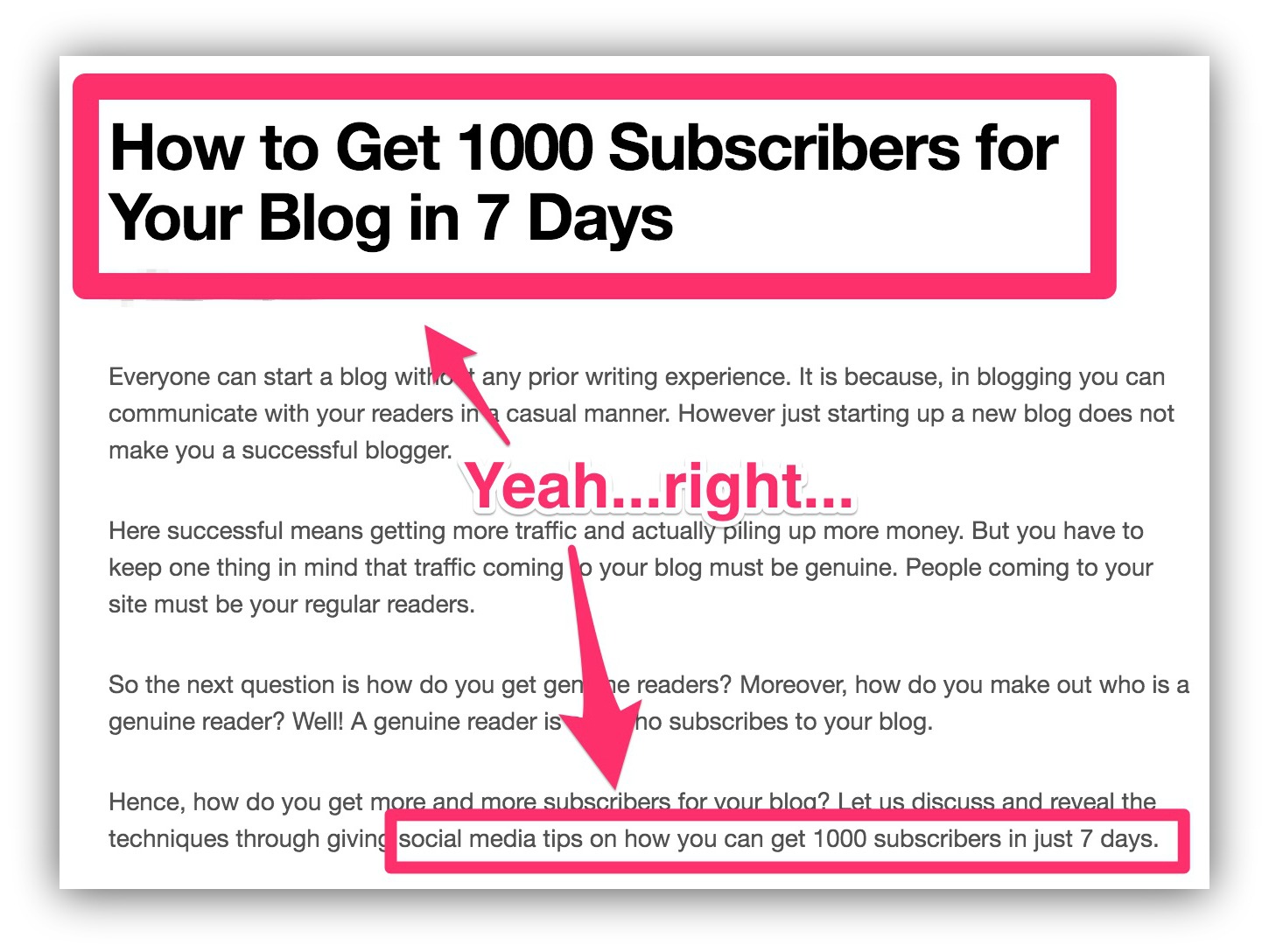
If it were that easy we’d all be internet millionaires by now. Outlandish claims like this are based on either one of two assumptions:
1. You’re a marketing expert.
2. You have a massive pre-existing audience.
When you get 100,000 monthly visitors, you can just install a pop-up and collect an easy 1,000 subscribers without even having to worry about content creation.
But if you’ve never built an email list before and no one in your industry knows your name, you need somebody to take you by the hand and walks you exactly through what to do, step by step.
Lucky for you, that’s exactly what I’m going to do today.
Getting my first 1,000 subscribers took me 6 months of:
- Trying every tactic and strategy book
- Writing thousands of emails
- Spending hundreds of hours on blog posts
- Creating countless content upgrades
- Promoting my work everywhere
But it does get better. The next 1,000 took just 50% of that time:
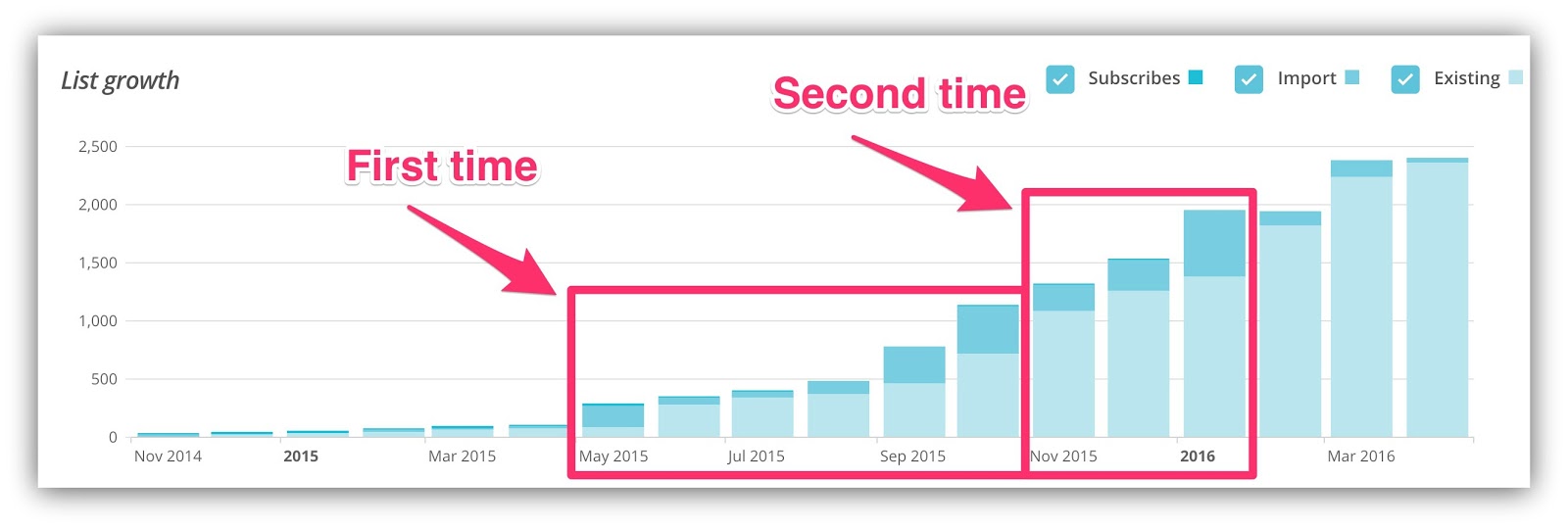
And I want you to get those first 1,000 subscribers and I want you to get them fast.
I’m showing you the exact system I used to grow Four Minute Books to almost 30,000 visitors, 837 email subscribers, and a cool $736.00 in affiliate commissions in just 60 days.
Want proof?
Here’s traffic…
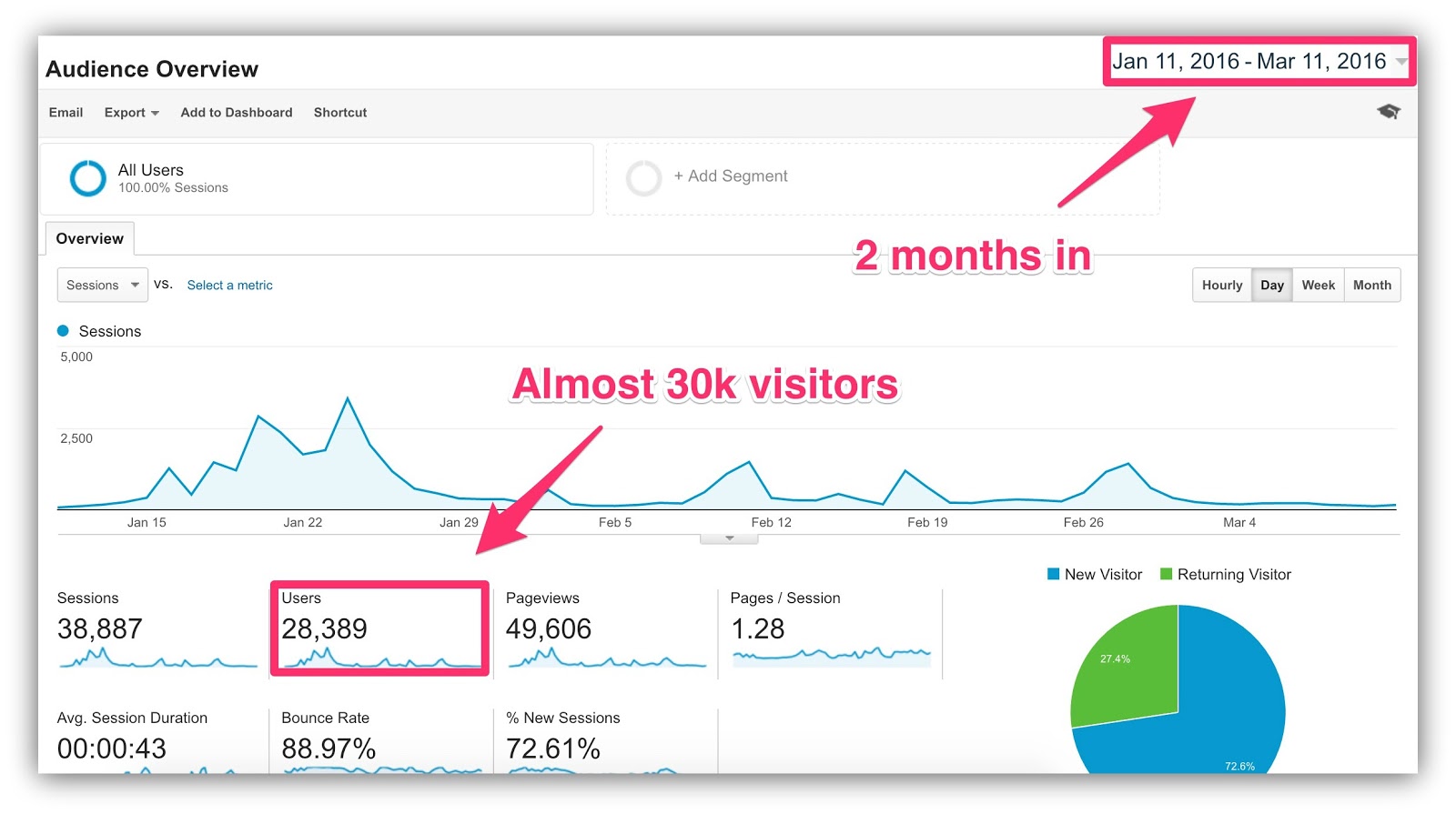
…subscribers…

…and commissions.

You can do the same. How?
By setting up a content creation process and streamlining your SEO and promotion, so you can write without thinking, publish every damn day and turbocharge your site’s growth (even if it’s brand new).
If I’ve done it all within less than 60 days of launching the site, so can you.
The best part? It costs $0 and you can do it all by yourself. I really mean that last part. No huge outreach campaigns. No asking for backlinks.
If you’re an introvert like me, with little SEO experience, and don’t like emailing strangers, then this guide is for you. If you’re sick of false promises, like this one…
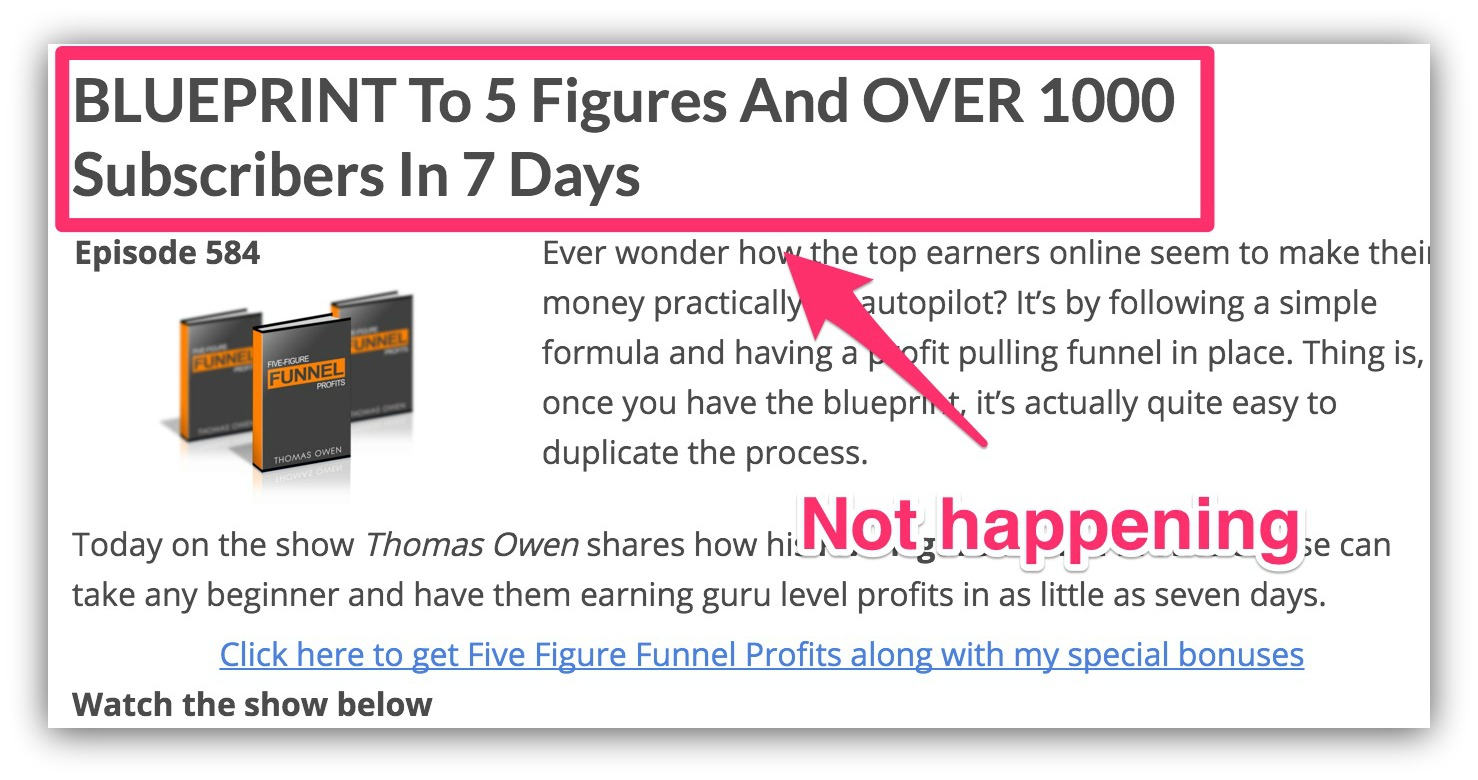
…then this guide is for you.
This isn’t for you if:
- You have a few months time and want to wait for SEO to kick in – We’ve got you covered there.
- You love promoting your content and are very active in a lot of communities – Sarah can show you how to do that.
But as long as you love writing, this will work for you. All it takes is a ton of time, lots of caffeine and a little sweat equity.

Here’s what I’ll go over:
Okay, let’s get cracking!

Step 1: Reverse Engineer Your Success
Building a successful website is hard. It’s probably the hardest thing I’ve ever done. The only thing that’s harder is trying to do it without a cause or plan.
Here’s how you can avoid failure and make your own life a lot easier.
Formulate Your “Why”.
Why are you building your email list? Why do you need more traffic?
Seriously.
You’re never building a website to “get traffic” or even to “build a list”. Both of these are means to an end. It’s about what you want to do with them.
For example, you might be building a list to sell your first ebook to, so you can start making some cash on the side and leave the office earlier every day.
In that case, your “why” is relief from financial pressure and stress – and it’s a much more powerful motivation than “get 1,000 subscribers”.
Staying motivated is huge if you’re going to make this work.
So how do you figure out what your “why” is?
Start by asking yourself one question:
What goal, if I achieved it with my website in 6 months, would feel life-changing?
Do you want to see your name on Forbes? Help build schools in Africa? Or earn passive income?
Knowing the end goal and what that end goal enables you to do gives you a point to work backwards from. For example, getting on Forbes might be your stepping stone to a career as a public speaker, and knowing what they require from their contributors will help you write articles in the correct style.
For Four Minute Books, my why is that I want the website to make $1,000/month in passive income because it would allow me to cut back a lot on client work and take the next step towards becoming a full-time writer and coach.
So what’s your “why”?
Pick A Way To Monetize Your Site, NOW
Alright, now that you have a strong cause, let’s talk cash.
If your website is supposed to make money at some point (it is, isn’t it?), you need to decide how exactly that’s going to happen right now.
Deciding this in advance will help you attract the right people and choose a format for your content that hands itself to be monetized.
For example, if you want to publish ebooks, you know you can target people who have a Kindle, and publish your blog posts in series which you can later condense into several ebooks.
Stuck on this? Here are some potential ways to monetize your site:
- Ads: For example via Google Adsense – this takes a ton of traffic to even remotely make sense, but some people, like this Dutch high school dropout, figure it out.
- Affiliate marketing: One of the most popular ways to make money online, and the easiest way to get started. Affiliate marketing lends itself well to creating content daily, and can be a product you’re passionate about.
- Courses: Online courses take a while to create and without an email list you’ll fall flat on your face, but can pay big dividends in the long run.
- Consulting: Use the expertise to offer coaching calls at a premium rate.
- Donations: Some individuals do this, and it can work well if you blog for a good cause, or a solo artist creating things in your garage or basement. Package it into a Patreon campaign.
- Ebooks: Offering an ebook can be similar to courses, but they take less time. Many people have built ebook empires by publishing regularly on Amazon.
- Lead generation: When you have traffic that’s interested in a specific topic, you can refer them to companies that sell products your audience might be interested in, for example through sponsorships.
- Sell physical products: Ecommerce takes a lot of time to get started and requires some initial investment, and is therefore rather a long-term play.
I chose affiliate marketing because it’s easy to set up, creates passive income and I had a product I loved so much, I felt very comfortable promoting it: Blinkist.
Alright, time to start publishing, right?
Hold on! First you have to…
Validate Your Idea
You didn’t think any true Sumo would let you get away with building something before validating it, did you?
If you don’t make sure people will pay you money for what you’re about to build now, how can you know if they’ll pay you later?
Take Coca-Cola for example. 99 years into their unprecedented soda success story, they decided to strip some expensive ingredients off their magic juice and call it “the New Coke”. Instead of testing whether people would love it first, they made a huge fuss about it and switched the formula for ALL products they sold.
But people didn’t want a change. In fact, they hated it. Coca Cola lost millions of dollars in sales and after thousands of protesters and angry phone calls, switched the formula back just 4 months later.
Validate your idea in a weekend, but spend no more than 7 days validating. Here’s how:
Get 3 people to buy whatever you’re going to sell.
Sticking with affiliate marketing as an example, set up your account and start telling your friends about the product. If they show interest, send them your affiliate link and ask them to buy.
To validate my idea, I did two things:
1. Sent my affiliate link to all my coaching clients after telling them about Blinkist and seeing if they’re interested.

Check!
2. Put up a banner on my website and tracked click-throughs and conversion.
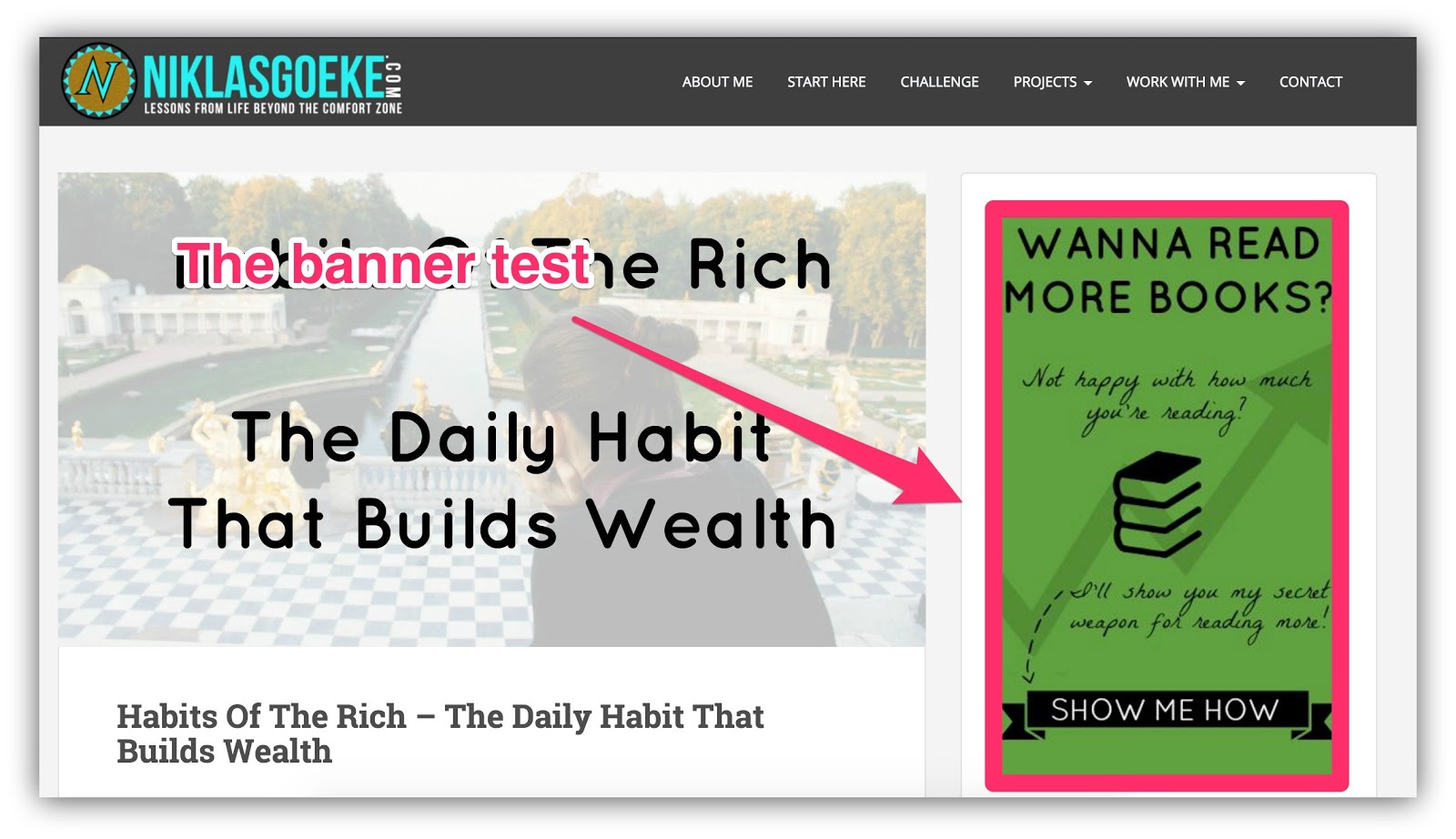
I saw 55 clicks over the first week and 5 conversions (even though people just signed up for the free trial, but the interest was there).
After 7 days the verdict was in: Validated!
If you see people interacting and showing interest in your product (like clicking your banner), and you can make 3 sales to people you know (without forcing your Mum to buy one), you can move on – if not, try a different offer.
Making one sale may be luck, and two can show you that your friends really like you, but repeating the process three times indicates that people actually want you to sell to them, because they get value out of the product.
If you can’t make three sales to your friends in a week, how can you possibly sell even more to strangers?
Protip: If you want to sell a course or other product that you don’t have yet, throw it up on Gumroad and pre-sell it.
And don’t overthink this.
It’s as simple as talking to the person right in front of you at the coffee shop right now – check out how Noah casually does it live, again and again. If you’re really unsure, even after you get three people to buy through you, check out what the competition is doing.
For example, I saw Mike Vardy also promotes Blinkist on Productivityist with a sidebar ad. Since I first noticed it, months went by, but the ad stayed – so it must get results!
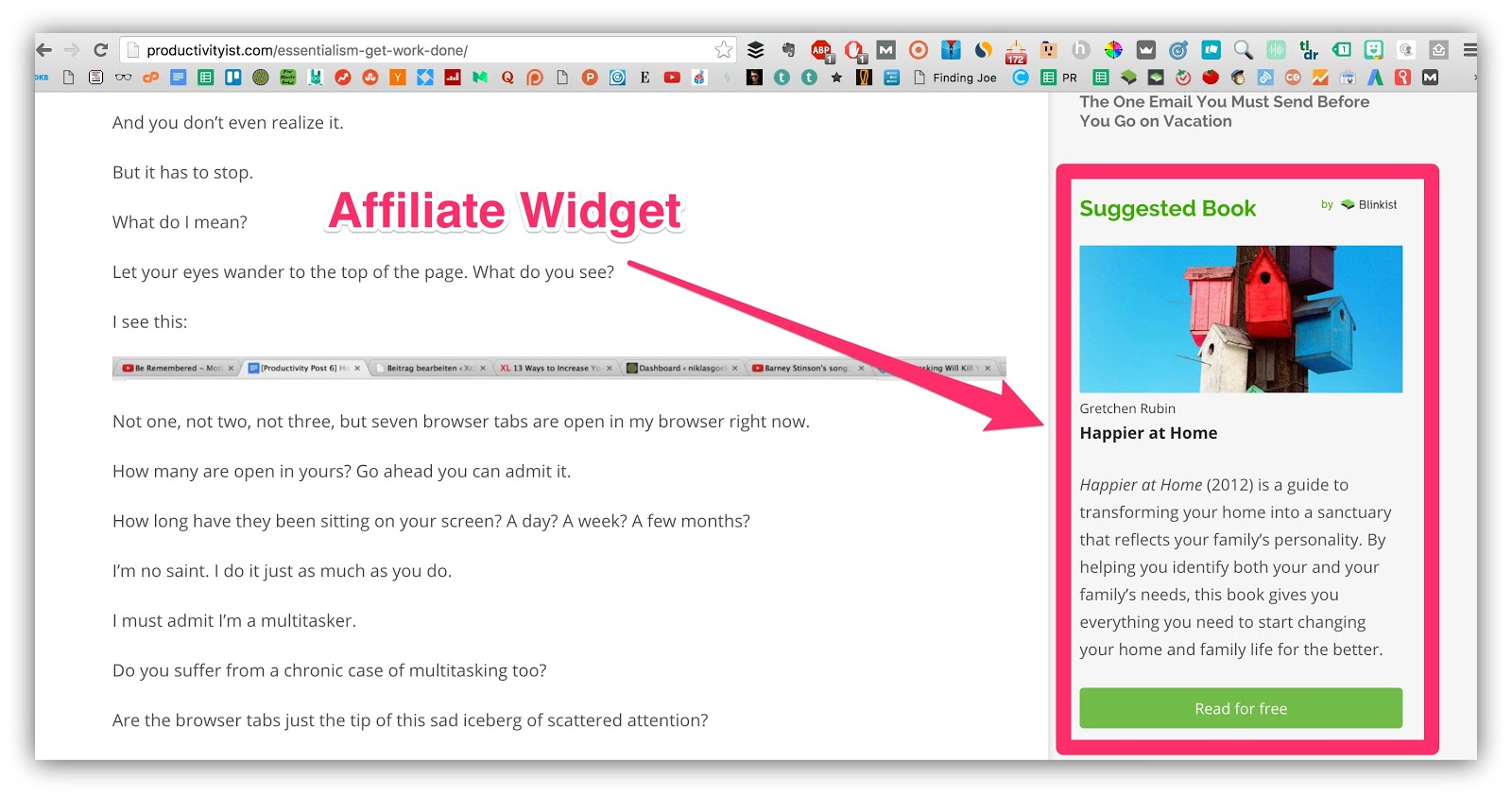
Pro tip: Use NerdyData to find who else is promoting your product as an affiliate. Grab a universal part of your referral link (that will be in all affiliate links for the same product), plug it in and presto – a list of sites who use similar affiliate links. Hat tip to Bryan Harris for this strategy.
Use Ghetto Math To Figure Out Your Monthly Target
Reason to do all this hard work? Check.
Offer you want to sell? Check.
Do people want it? Check.
Now all you have to figure out is how much you have to sell. For example, Blinkist has two pricing levels, Plus at $50/year and Premium at $80/year. My one-time affiliate commission is 50% of the annual fee, so $25 for Plus and $40 for Premium.
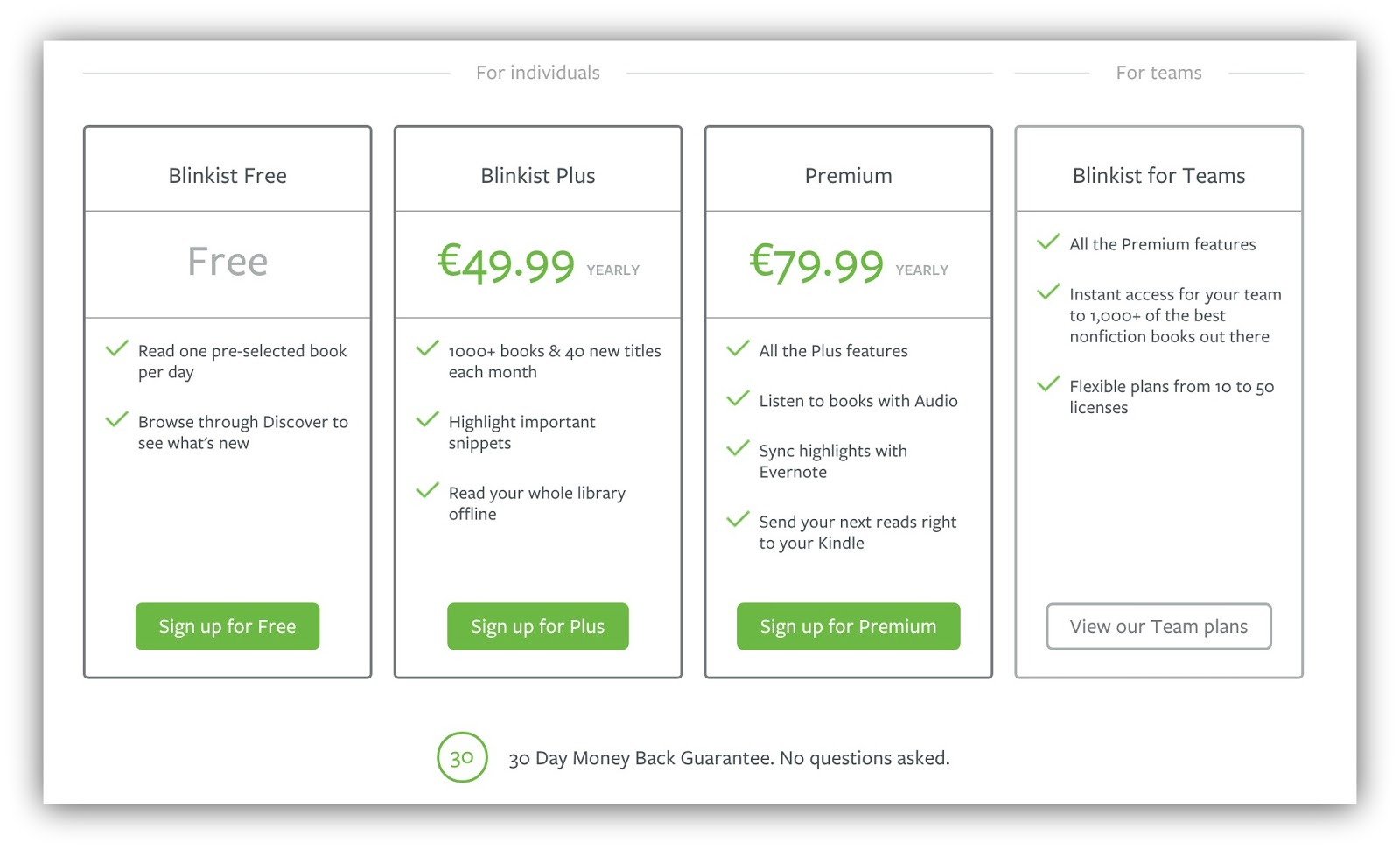
(prices translate to € 1:1)
Assuming 70% of people take the cheaper one, this works out to an average of $29.50.
![]()
So to make $1,000, I’d have to sell 34 subscriptions in a month.
![]()
Looks much more doable than $1,000 right?
Note: Neville Medhora recently built an awesome calculator to figure out your exact numbers easy peasy. Boom, now you have a very tangible goal to work towards.
Time for step 2.
Step 2: Streamline Content Creation – And Everything Else
Remember I said this guide will help you to publish every single day? I meant that. Therefore, you’re gonna be spending a TON of time creating content, so you won’t have any to try advanced SEO tricks, send hundreds of emails, or fix your pop-ups, at least in the beginning.
Luckily, you won’t need to, because we’re going to streamline ALL of it.
In fact, we’ll even build a buffer of ideas and research to draw from, so literally all you have to do is sit down, write and press publish every day.
There are 4 parts to streamline.
- Content
- SEO
- Email collection
- Promotion
We’ll start with the king: content.
Part #1: Content Creation
To create content like you’re an assembly line, you need a structure and ideas.
Here’s an easy-to-follow process:
The 1-in-1-out System to Minimize Research
You probably have a ton of ideas for articles. I’ve got at least 50 sitting comfortably in Evernote right now.
But we’re not going to use any of them for this.
Why?
Because when you have an idea, you want to do it right. The reason these ideas are all still just drafts or headlines in your mind is because you’d never just crank out that article and ship it.
It was YOUR idea after all, it needs to be perfect right? Sorry, we can’t afford perfectionism here. Instead, use what I call the 1-in-1-out system.
You get one piece of content to learn from, and then you write about what you learned.
That’s it. One piece. No more.
It could be a blog post, a question, a Youtube video, an infographic – any kind of content is fair game, as long as it’s just one piece. For example, since Blinkist has over 1,000 book summaries in their library, I can just read one per day and then write about it.
But you can do the same, no matter what you want to sell (I’ll show you how). That way, you limit the time you spend on reading and writing every morning.
In fact, let’s build a month worth of article ideas right now.
I’m big into coffee, so how about we start an imaginary coffee blog? Let’s say you want to promote Bulletproof Coffee as an affiliate and call it Coffee Connoisseur.
Create a new spreadsheet in Google Docs and insert 4 columns: input title, input URL, output title and output keyword.
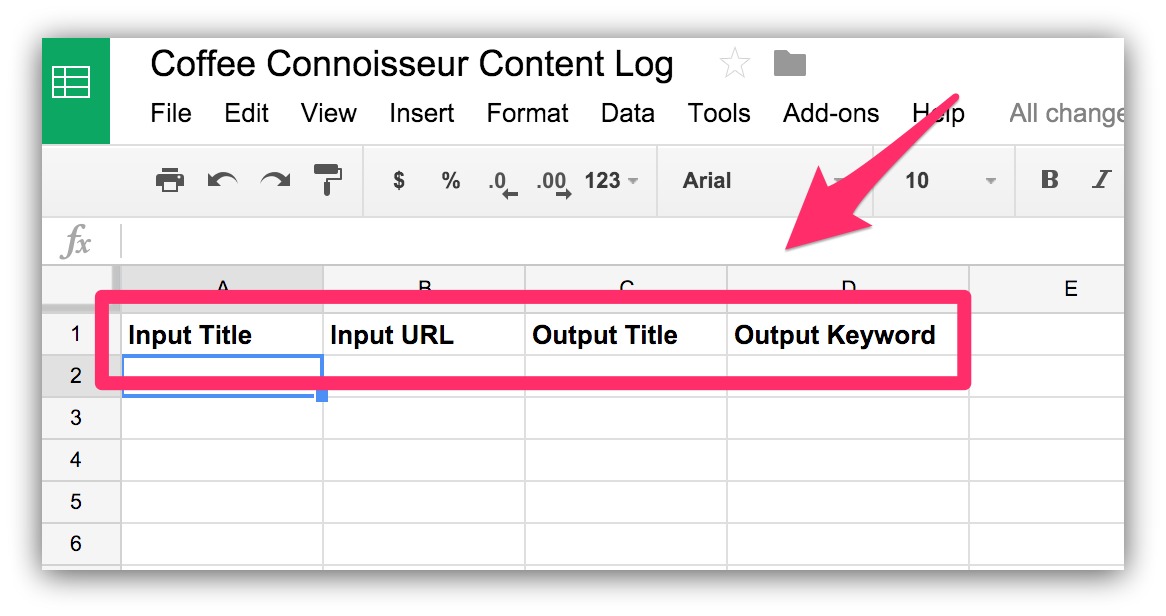
Now where do you get your inputs from? Here are 3 great places to start:
- Medium
- Quora
- Youtube
Click on a few articles that strike you, skim them to get the gist of what they’re about and then plug title and URL into your spreadsheet.
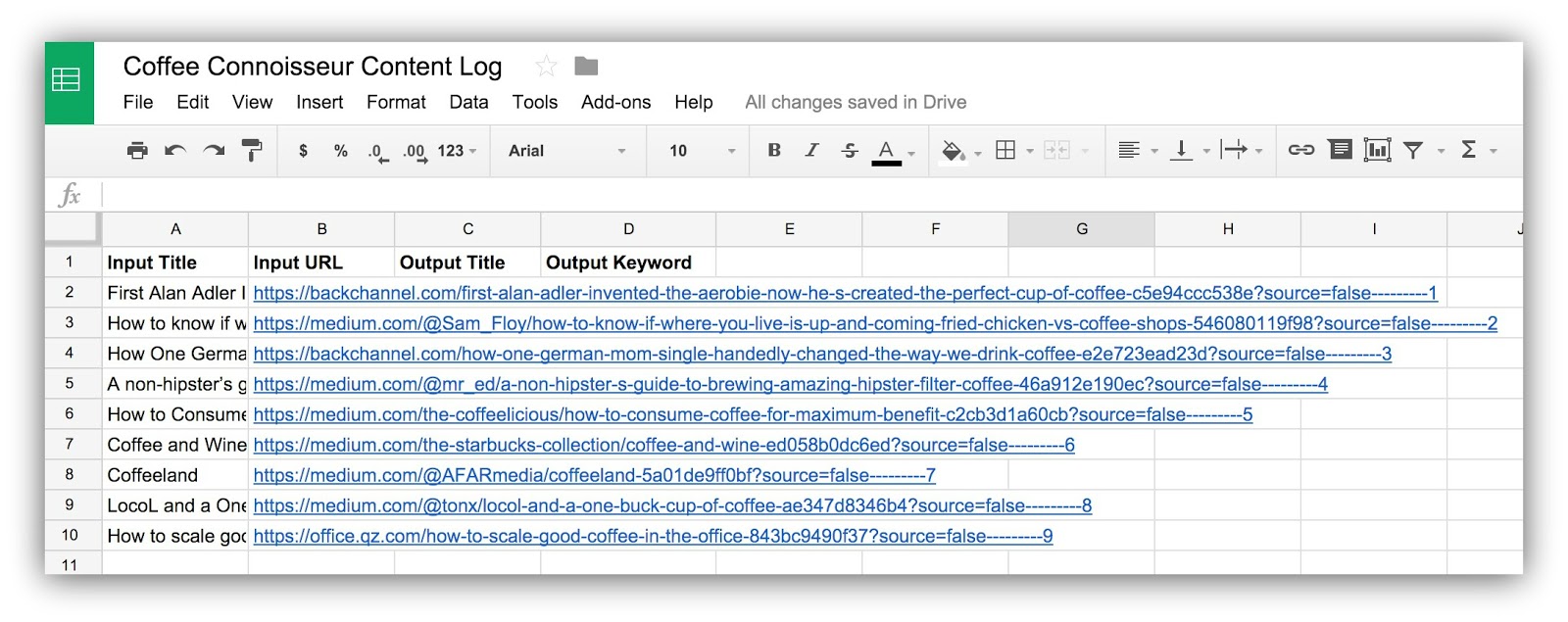 On to Youtube, same game.
On to Youtube, same game.

5 minutes later, we’re up to 20 inputs pieces of content.
Alright, one last stop: Quora. Search for coffee, but set it to questions.
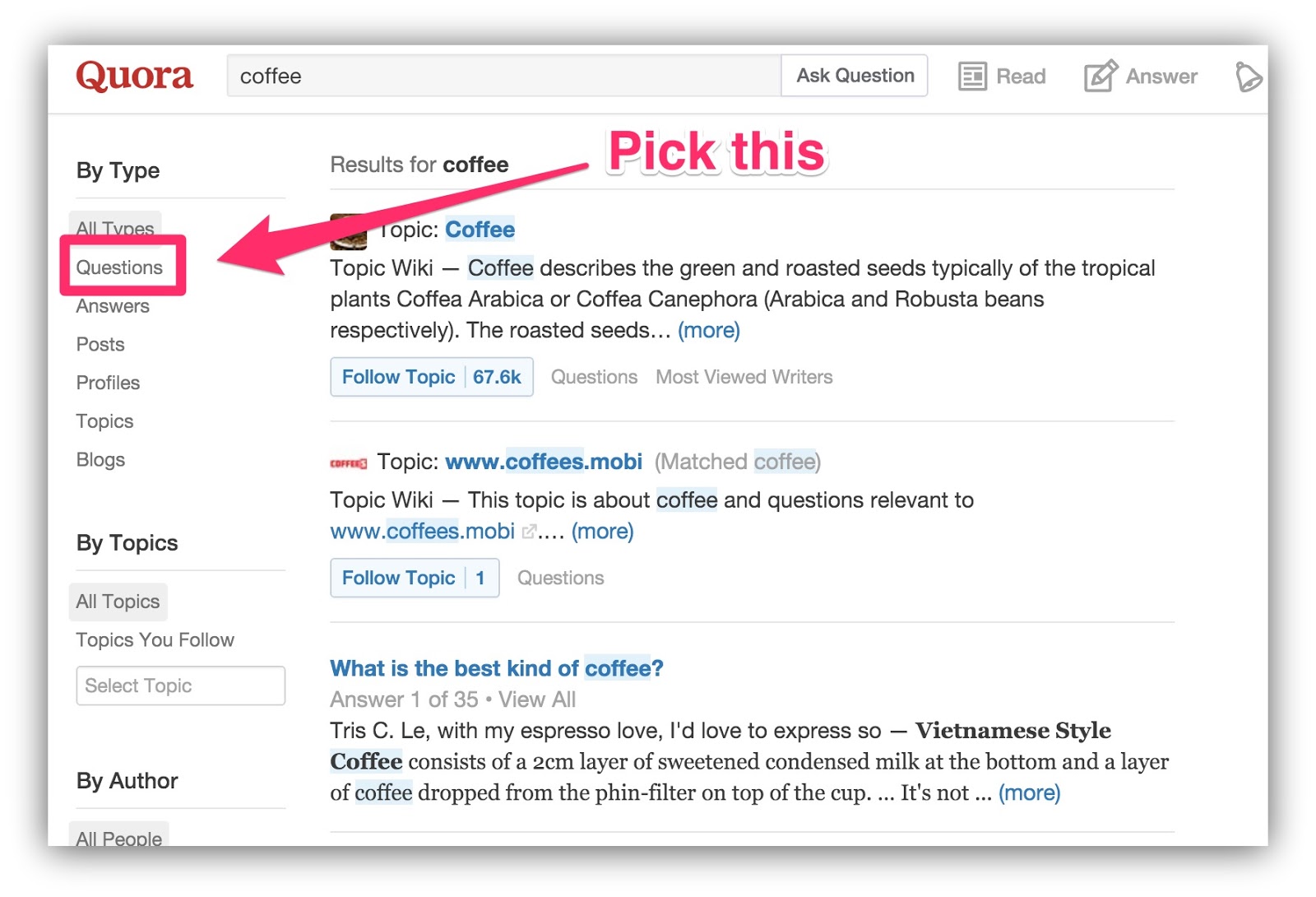
Pick some interesting questions you already have an opinion about, and add them to your spreadsheet.
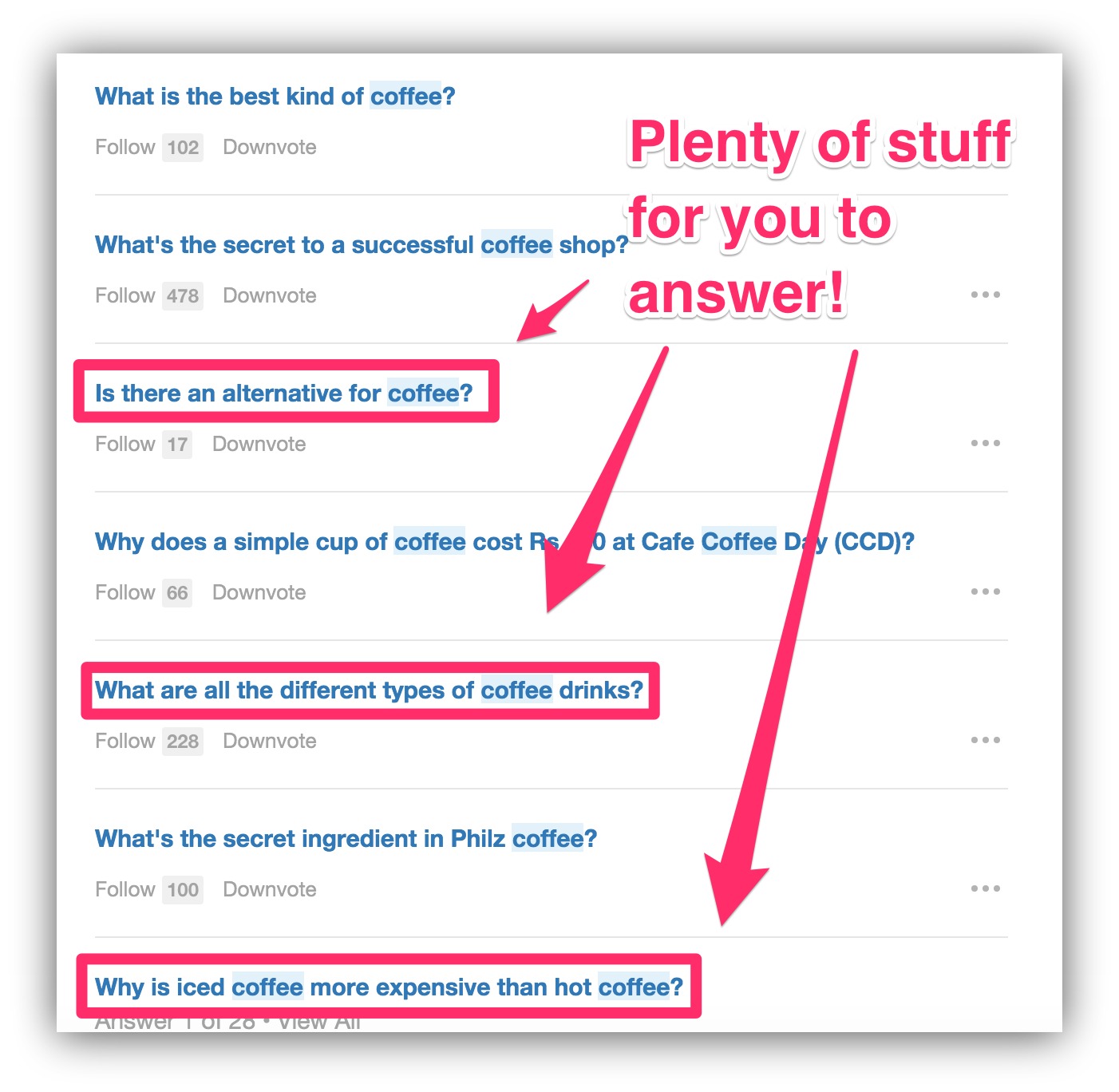
Grab another 10 here and you have a 30-day content buffer, awesome!
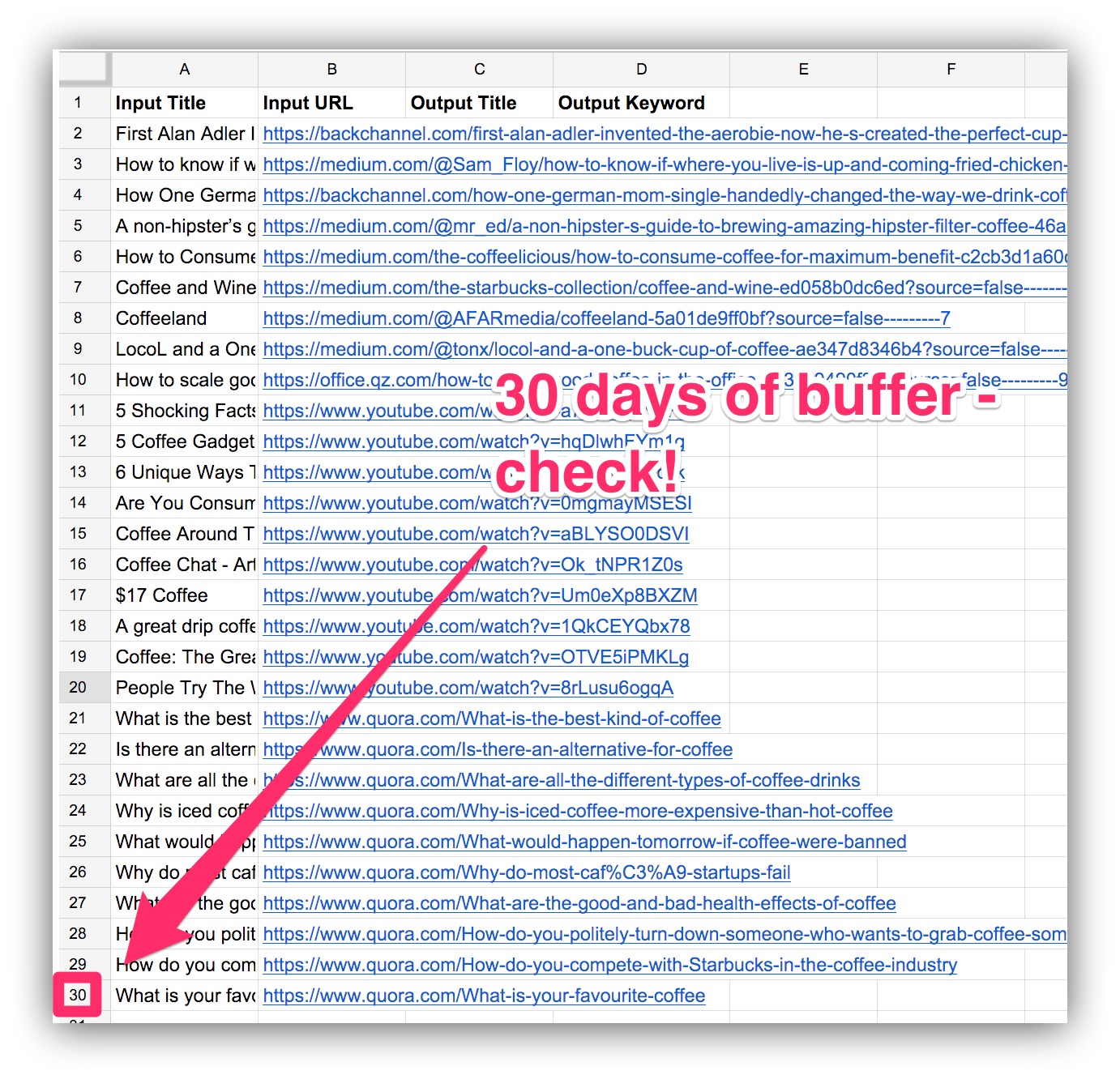
Pro tip: If you want to make it even easier for yourself, stick to one source for each month. For example, grab 30 articles from Medium, then 30 Youtube videos, etc.
The reason you have to skim the content is so you can come up with a potential headline. This needn’t be final (you’ll see why soon), but will make your life so much easier when you sit down to write.
For example, the very first article is an interview with Alan Adler, inventor of the AeroPress.
You can easily mesh and tweak the headline and sub headline from the original piece for your own purposes – “He Invented The Perfect Cup Of Coffee At Age 76” and make your sub headline “Today I Learned How The AeroPress Was Born”.
Or, just use Sumo’s cool headline generator.
Similar to the validation part, don’t overthink this. Spend no more than an hour on generating ALL your headlines for the month – it took me 20 minutes for this example.
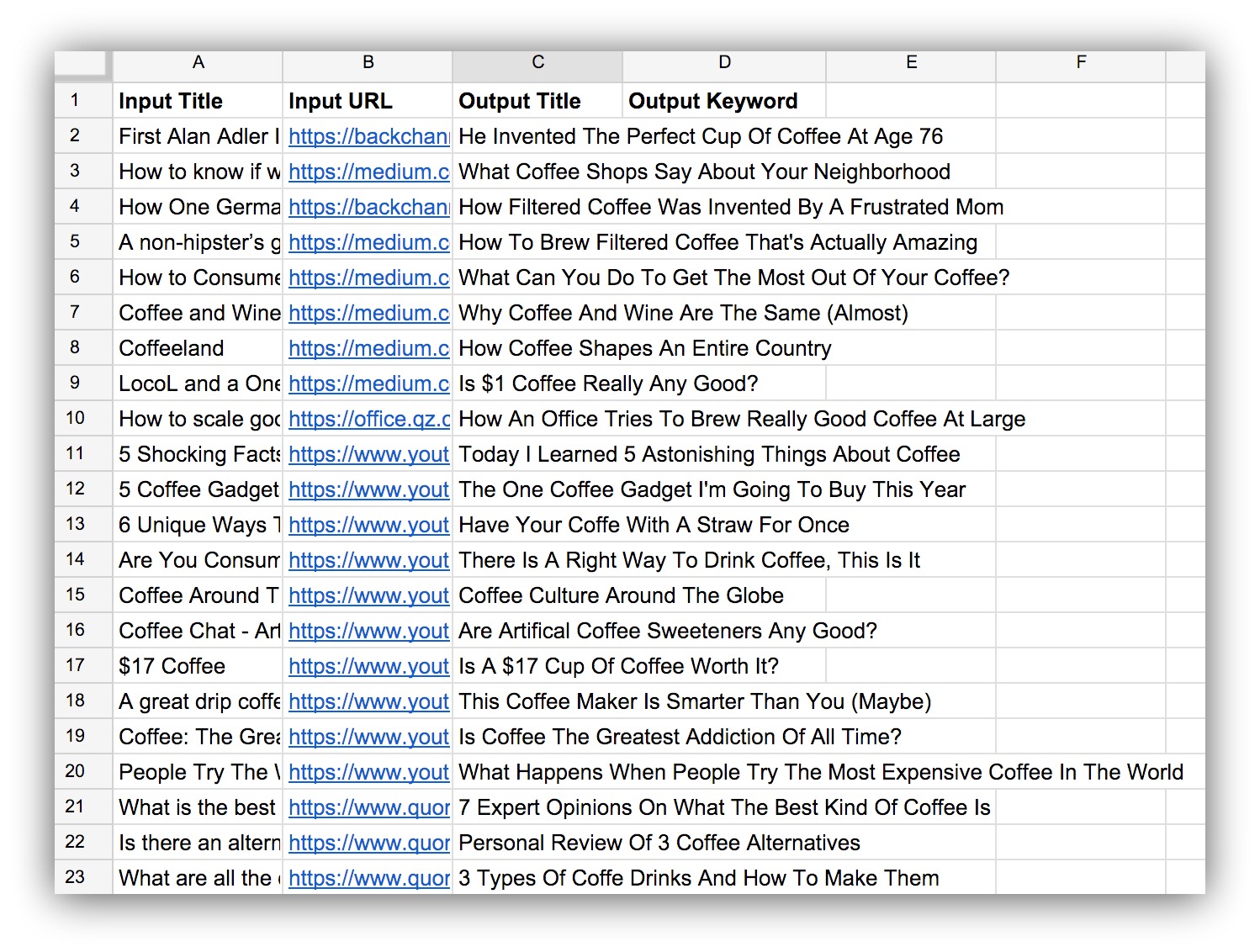
There you go, an entire month of daily content mapped out in an hour.
Some other good places to discover input content are StumbleUpon, Flipboard, Product Hunt, Buzzsumo, and the Google.
Now you have to put a structure in place (don’t worry, we’ll get to the keywords).
How To Create An Evergreen Structure For Your Blog Posts (And Why You Need It)
What’s an evergreen structure? Basically, it’s a way to outline your blog posts that you can use over and over again.
For example, Buzzfeed has several different structures, like lists (“22 Avocado Recipes Worth Trying”) or quizzes (“Which Carly Rae Jepsen Song Are You Based On Your Zodiac Sign?” – yes, that one’s real).
What’s great about it is that you can define the structure once, save it, and pull it out of your digital archive every time you publish a new blog post of the same type to save tons of time.
For Four Minute Books, I knew I wanted to share lessons from non-fiction books, so there had to be some information about the author of each book. Since I planned on promoting Blinkist as an affiliate, a review component also makes sense.
Here’s the structure I came up with:
- One sentence summary of the book.
- Estimated reading time.
- Favorite quote from the author.
- Intro with information about the author and 3 lessons from the book ~ 100 words.
- First lesson ~ 200 words.
- Second lesson ~ 200 words.
- Third lesson ~ 200 words.
- My personal takeaways ~ 100 words.
- CTA section to get Blinkist.
- What else can you learn from the summary on Blinkist ~ 100 words.
- Who would I recommend the summary to ~ 50 words.
- Related summaries (done with Yet Another Recommended Posts Plugin)
It contains everything someone who’s interested in reading an extensive summary of a book needs to know – the basic information, a few interesting tidbits from the book itself, plus a teaser of what’s to come. In addition it gives readers several options to take action and doesn’t leave them hanging.
By using this same structure again and again I make sure to have all of these valuable elements in every single one of my blog posts, without having to think about them.
All in all, this comes out to roughly 1,000 words per post, which is a good mark to shoot for.
It puts you above the 300 word blurbs and listicles on Buzzfeed, but below the long and actionable guides, which take a lot longer to produce.
This is what it looks like in action:

You might think that’s rigid, but having a structure that’s this clearly defined will allow you to literally copy and paste it, and fill it in for every new blog post, which is exactly what I do.
Pro tip: Save your structure as HTML in Evernote and then drop it into the text editor in WordPress for each new post, to minimize formatting hassles.
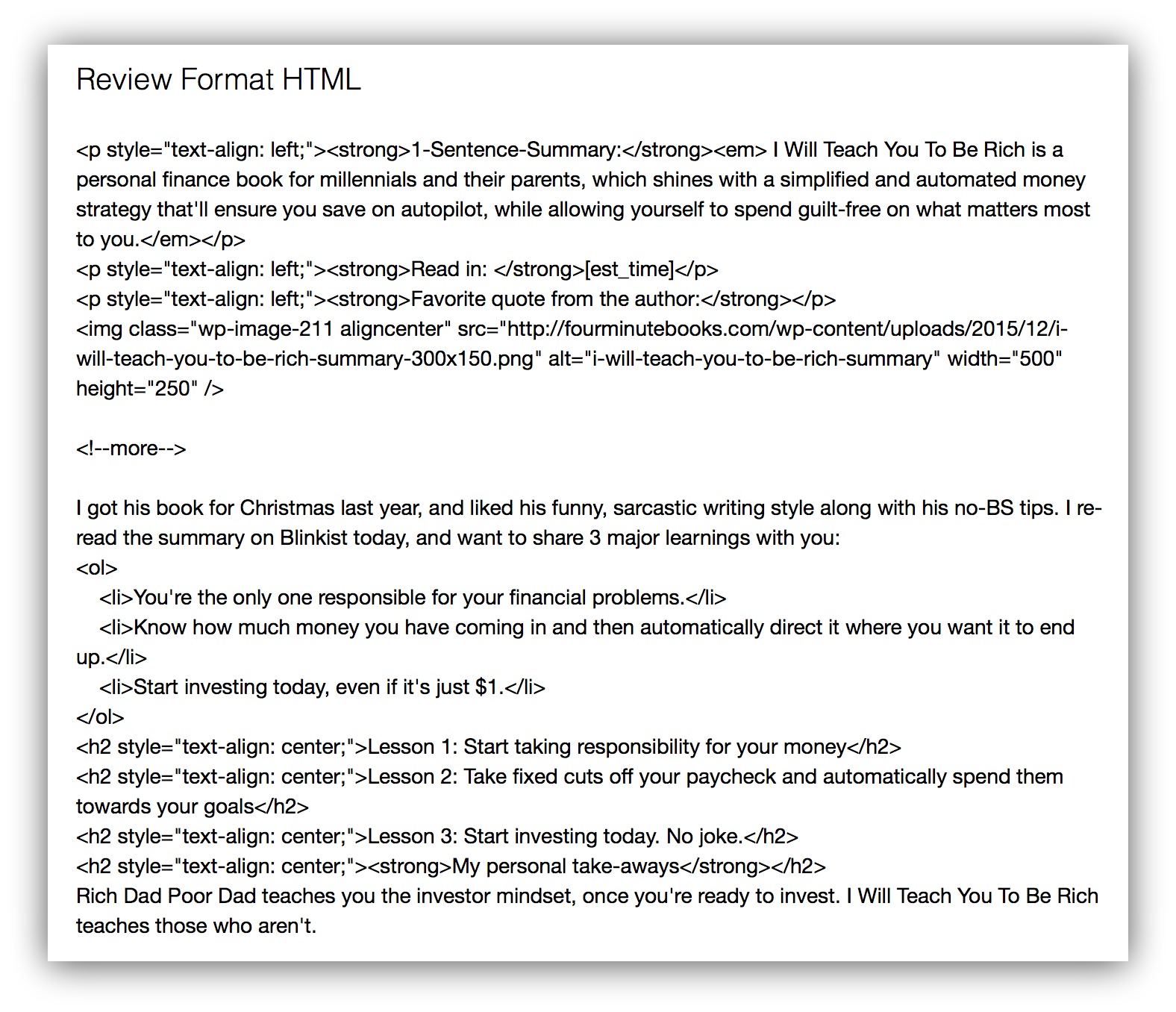
However, you can’t copy and paste the one I’m using, because it depends on what your topic is about and what you’re trying to make people take action on, so here are some guiding principles for the intro, core section, and conclusion.
Intro
Start with something engaging. A thought-provoking question. A shocking fact. But grab your reader’s attention. If your first sentence is boring, no one will read the rest of your post.
Provide some background information. Who wrote the article you’re referencing? What’s that Youtube show about you just watched? How did that study come about? People want to know.
Tell people what they’re about to learn. Nobody wants to wait until they’re 75% through a post to find out what they’re actually getting out of it. You wouldn’t have read this far if you did
Include a signature picture, but no more. I don’t mean a header image and I don’t mean screenshots. Make it part of the structure. It could be a quote of the day, a cool coffee wallpaper, or a fun fact. This will help SEO, plus people are 80% more likely to read a post with a colorful image above the fold.
Core Section
Chop it up. Don’t try to fill your middle section with 600 random words. Using 3 parts works well. You could answer 3 questions, provide 3 lessons, give 3 intriguing thoughts or ideas, or even a mix of all of them. It’s so much easier to write 200 words several times than 600 in one go.
Keep it valuable. Don’t rant, gossip, complain or point fingers. Make it helpful. You can include your opinion and personal experience where applicable, but don’t give an award speech – you haven’t won an Oscar (yet).
Conclusion
Re-state what people learned. Do it in a quick list of bullet points. It’s the easiest way to wrap up and helps people remember your post.
Share your opinion. But again, stay objective. Don’t use harsh language, but don’t praise something to the skies either.
Have a call to action. Tell people what to do next, even if it’s just reading another post on your site, or signing up for your email list.
Don’t worry about the nuts and bolts of your structure, at first, there’s plenty of time to fix it. When I started publishing, my structure looked a lot different. When I look back at my first post, I think it’s awful.
The point is I set a structure and stuck with it until I could come up with a better one.
It’s much better to have a bad structure and ask every single reader for feedback to make it better than to have no structure at all and thus, no readers.
But for you that won’t happen. Why? Because next, we’ll make sure that Google is your fan and sends you a whole bunch of them.
On to SEO.
Part #2: SEO
Professional SEO’s will probably definitely want to slap me for this, but it works.
The only thing you’ll try to do with SEO in this guide is to tell Google that a new blog is in town (in your industry).
If you don’t do this now, it’ll be incredibly hard to get Google to notice you later. Get a few basics right, however, and you put your blog into a great position with a good baseline of organic traffic, which you can explode later by landing a few big hits (and watch all your posts rise in Google’s ranks).
Here’s how to do it.
Find The Keywords You Already Have
Think of the most generic word you can that people might search for when looking for your blog. In our example, it’d be “coffee”.
Now go through your list of headlines and check if you can find a word combination of 2, 3, 4 or even 5 words in each one that includes your top level keyword.
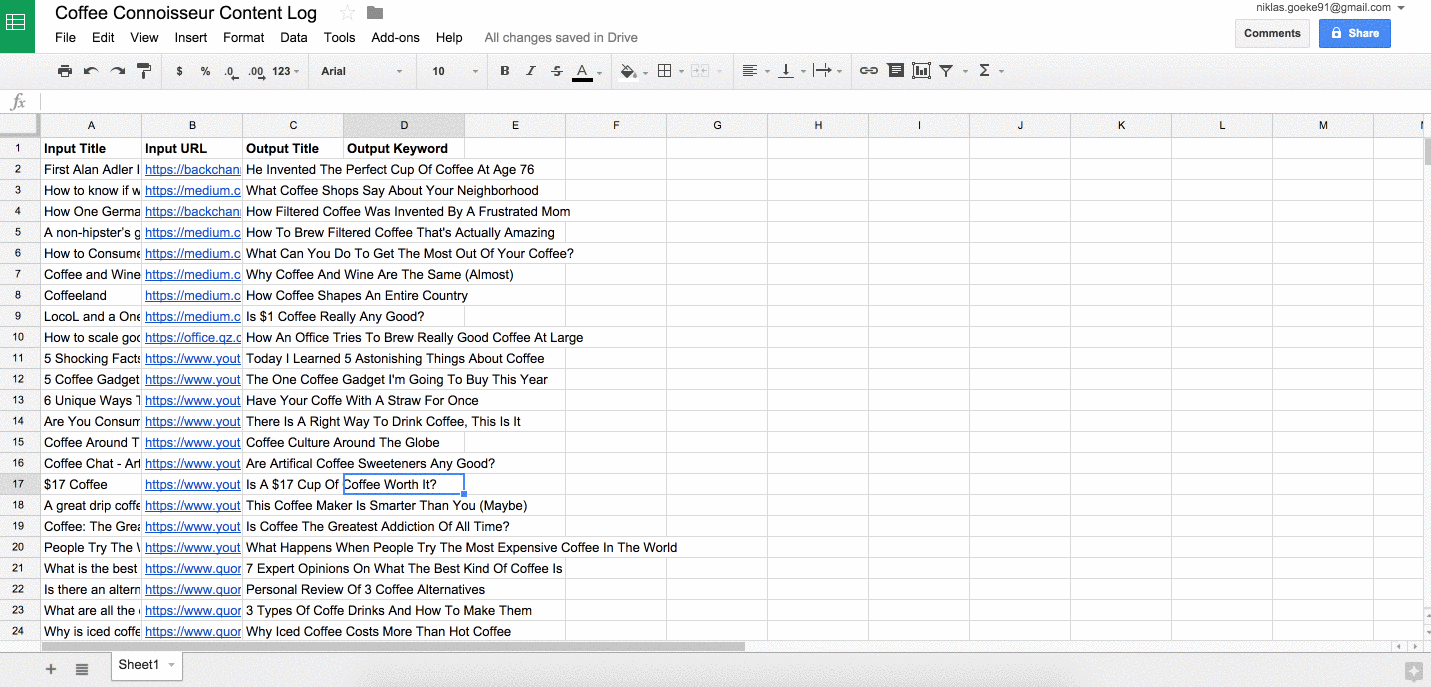
For the ones you can’t, leave for now.
In this case, 24 out of 30 headlines already had a usable keyword in them. For example, “How Filtered Coffee Was Invented By A Frustrated Mom” lends itself well to the keyword “filtered coffee”, and so on.
Re-work Headlines That Didn’t Include A Keyword Already
Now you can simply do a second run-through and re-work the headlines a bit in order to integrate a multiple word keyword that fits.
For example, “What Can You Do To Get The Most Out Of Your Coffee?” isn’t great, but “What Can You Do To Enjoy Coffee More?” isn’t so bad, as you can get “enjoy coffee” or “enjoy coffee more” from it.
Most times it’s just a matter of re-ordering the words.
When “Is Coffee The Greatest Addiction Of All Time?” turns into “Is Coffee Addiction The Greatest Of All Time?” you can now target “coffee addiction”, for example.

Check Search Volume
Now, copy the keyword column and plug it into the Google keyword planner. Check if all keywords show a search volume. If they do, you’re good.
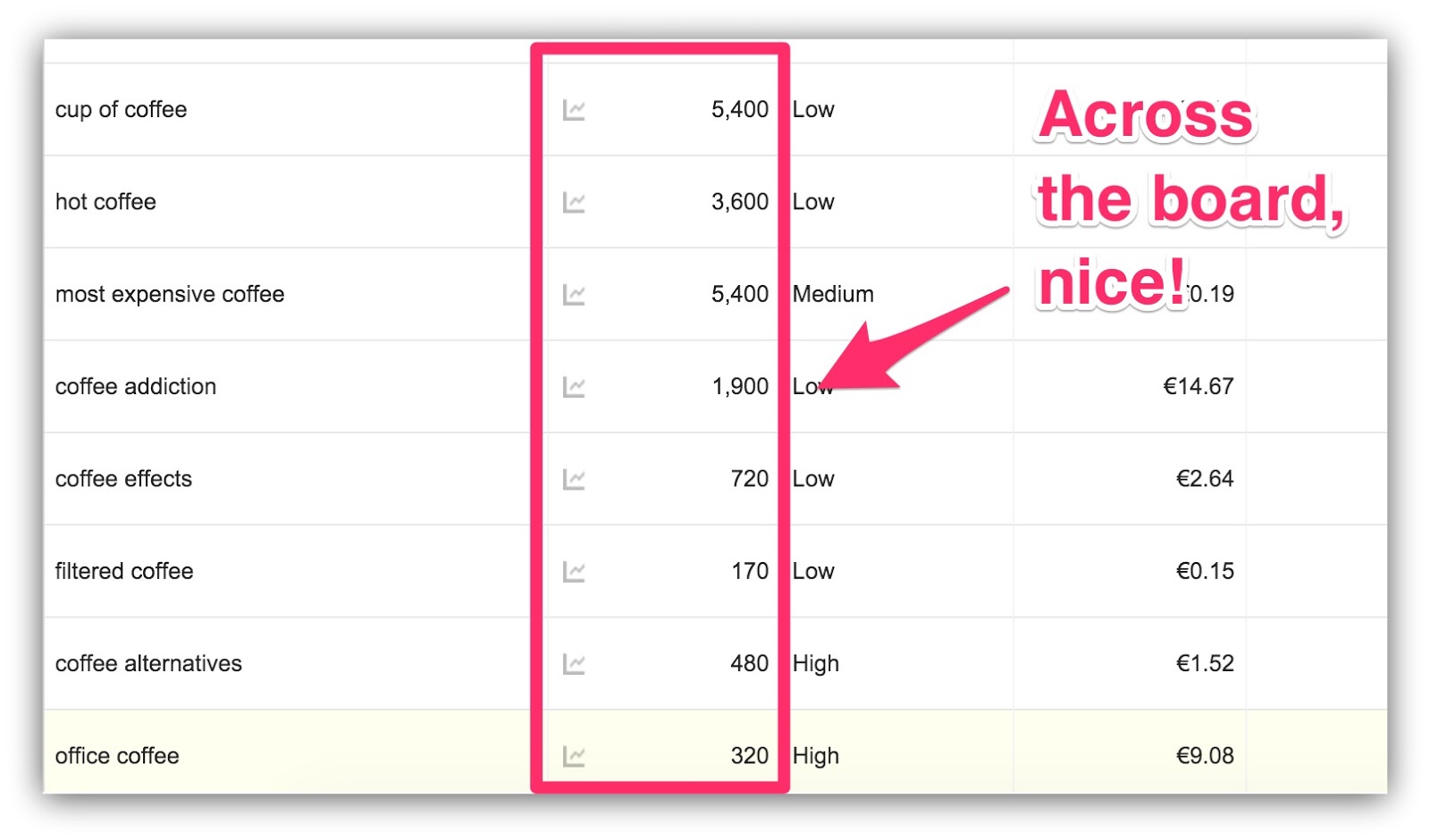
If not, move on to the next step.
Adjust The Laggards
Some of your keywords might not show any search volume.
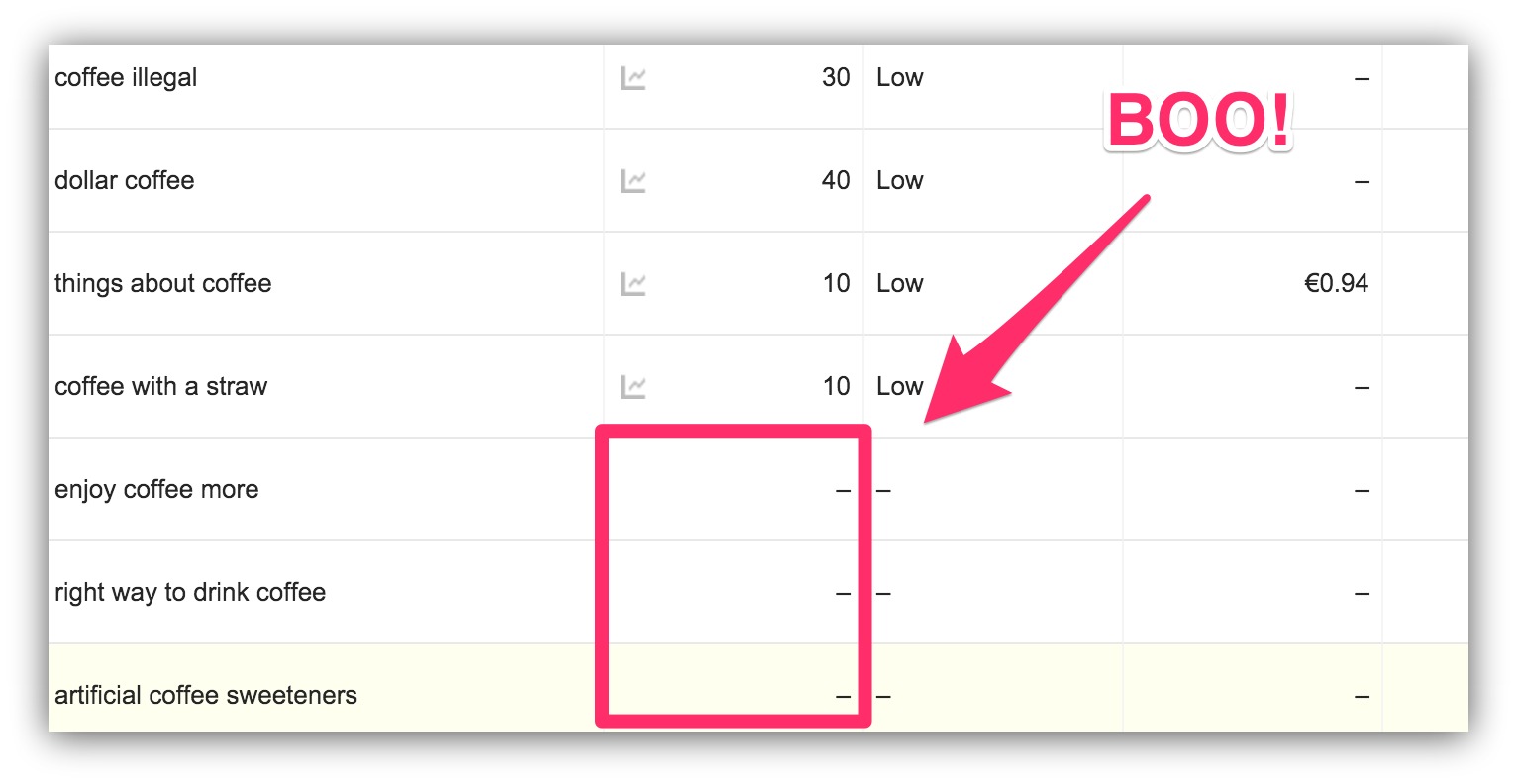
But that doesn’t mean people don’t search for them.
Just open Google and see if their auto complete feature recognizes them.

If it does, you’re good – you can still create this content. If not, adjust it to the last recognized part. In the example above you can adjust “enjoy coffee more” to “enjoy coffee”, the other 2 work out.
Done! Now here’s how to integrate your keywords into your content.
Integrating SEO Into Your Content Structure
There really are only a few places to use your keyword in for maximum effect.
- Title/headline of your article.
- Slug (=the URL) of your article.
- Once or twice inside the body’s text, maybe in a sub-headline and a paragraph.
- As the alt tag of your signature picture.
- Inside your meta description.
Here’s how to do it in WordPress:
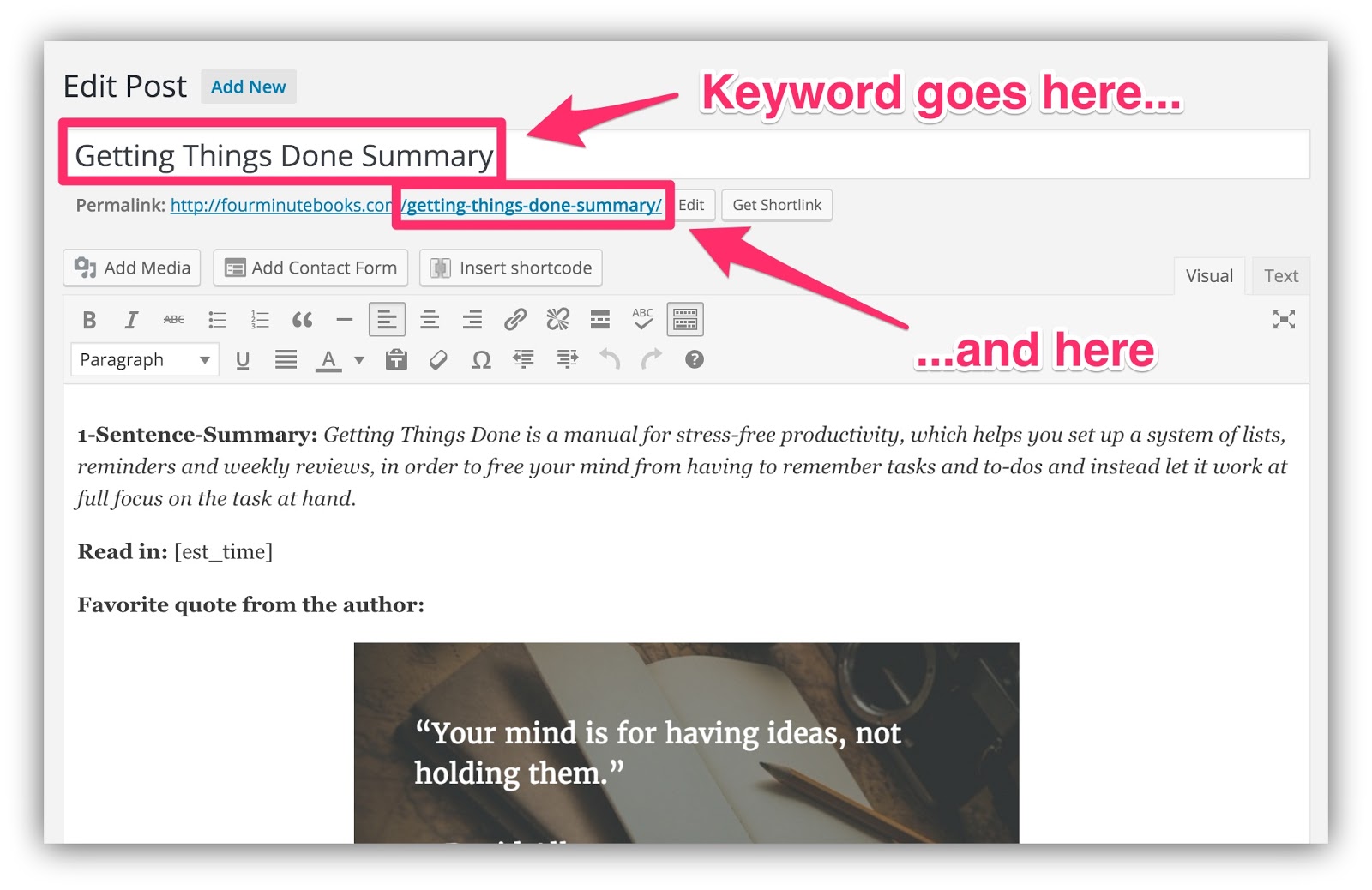
The signature picture is important because it makes sure you have at least one picture with the right tag.
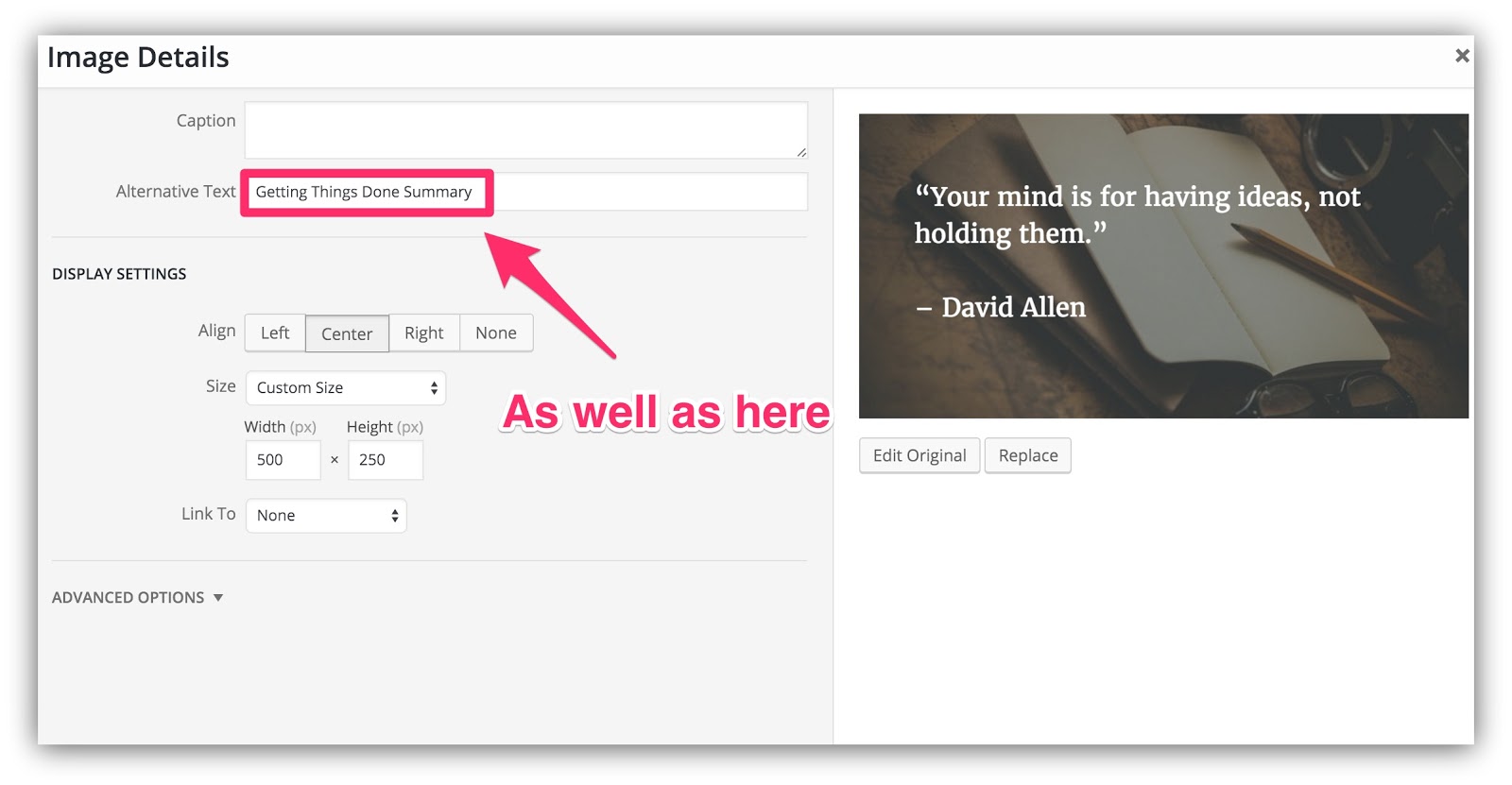
I only use my keywords once in the body (if you can do twice that’s even better).

The meta description is the short excerpt that’s shown in the Google search results.
The easiest way to edit it and simultaneously make sure you check all the other basic on-page SEO boxes with each post is to use the Yoast SEO plugin (the free version is fine).
It’ll show the meta description right at the end.

Once you’re done you can simply go through the checklist at the bottom, if you’re green overall (shown at the top), you’re good to go.
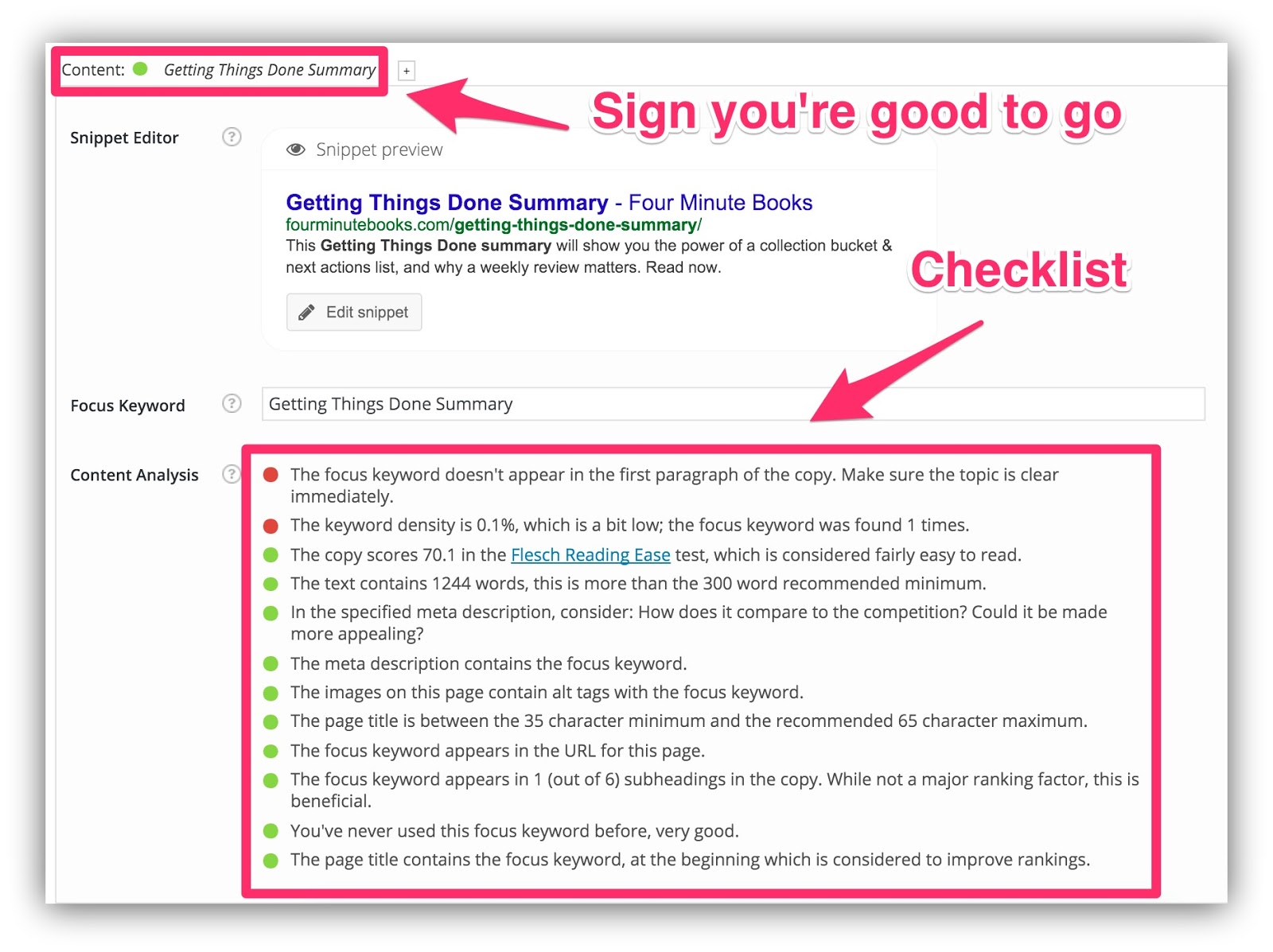
Does This Really Work?
Yes.
You’re building content and loading Google with texts for it to index, centered around a certain topic or main keyword.
You might even see a few top 10 rankings based on this minimalistic SEO approach alone, just because the scope of keywords you’re targeting is so broad.
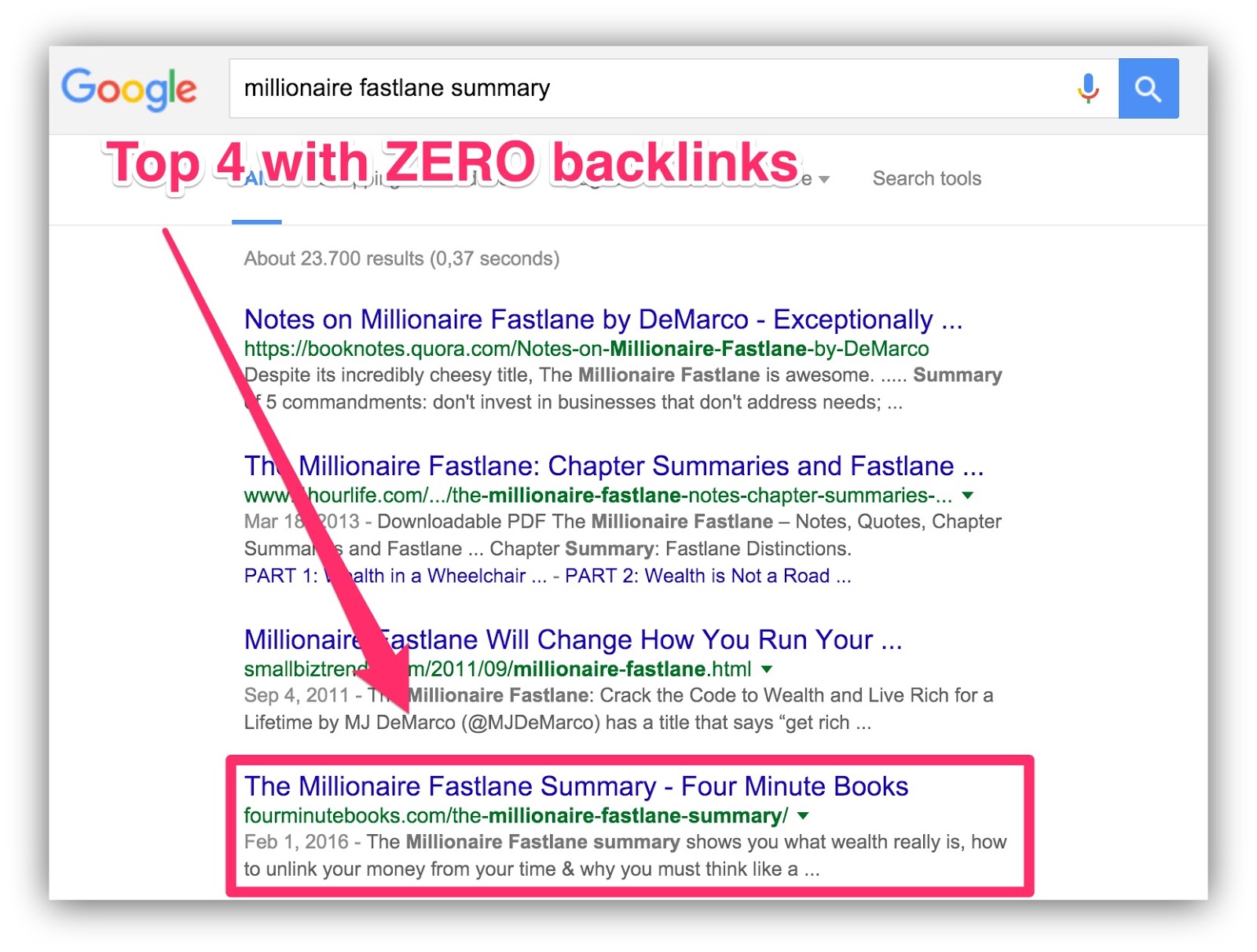
It works because you’re clearly making yourself heard in Google’s ears for the same topic, again and again, and again.
After a quick keyword comparison between a few book titles for “summary”, “book summary”, “review” and “book review”, I found that [book title] + “summary” usually had the most search volume, so I stuck with that formula for all my posts, and still do.
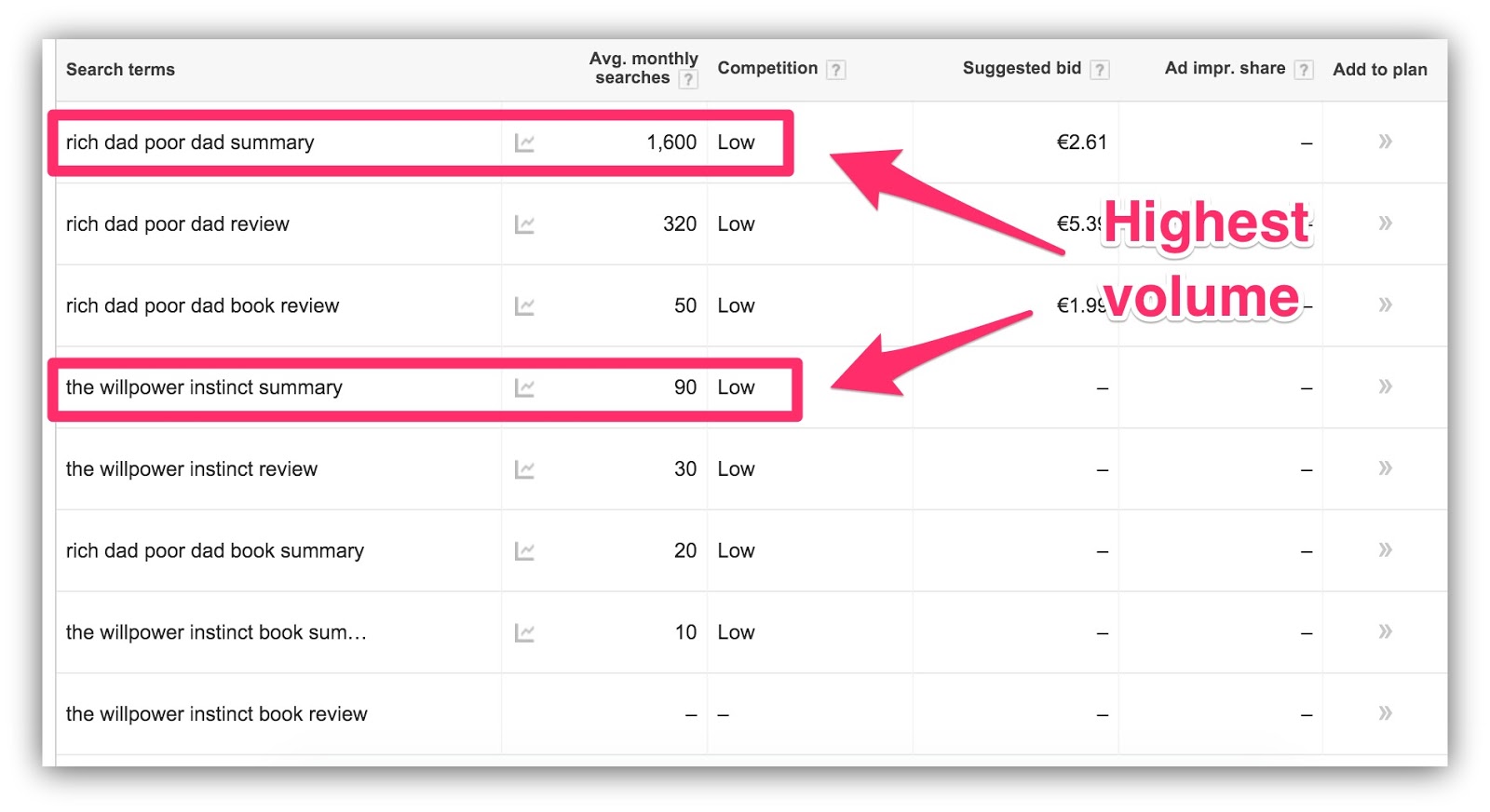
The lack of time you spend with the optimization of each individual post is forgiven by Google because publishing daily will shoot your number of indexed pages through the roof quickly.

Over 2 months, this will slowly but steadily lead to climbing impressions and clicks and build a baseline of organic traffic that you can blow up later.
Even better: Because by then you have so many ranked pages, landing one big hit – for example with a relevant and well-written affiliate article – will drag lots of your older posts right with it and boost SEO traffic even more.
Part #3: Email Collection
I shouldn’t even have to tell you this, but yes, collecting emails is a must. Having a list of people eager to read your next piece of content, who you can contact again and again, is priceless. You can build a relationship with them and of course sell your products.
You only need 3 simple tools to do it, all of which you’re very much familiar with (I hope).
- Welcome Mat
- List Builder
- Scroll Box
If you don’t already have Sumo set up, get on it right now. We’ll wait…
OK, ready?
Welcome Mat
Welcome Mat is hands down the most important list building tool ever.
Welcome Mat is responsible for 77% of my subscribers so far (you’ll see why in the promo section).

If you have your Welcome Mat set up properly, you can convert at least 3-5% of your visitors into email subscribers. The best part? I’m not even giving away anything fancy and you don’t have to either.
Here’s what my copy says:

Yup, that’s it.
I’m promising people exactly what they’re going to get – awesome content. Whoever signs up gets the best summaries, hand-picked by me.

If you’re going to deliver on such a high level (namely every day of the week) that’ll be a big enough incentive itself.
I set Welcome Mat to show on all pages and hide for 3 days after someone’s seen it.
Pro tip: Make sure you select “Do not show if already subscribed” so your subscribers are interrupted less as a bonus.
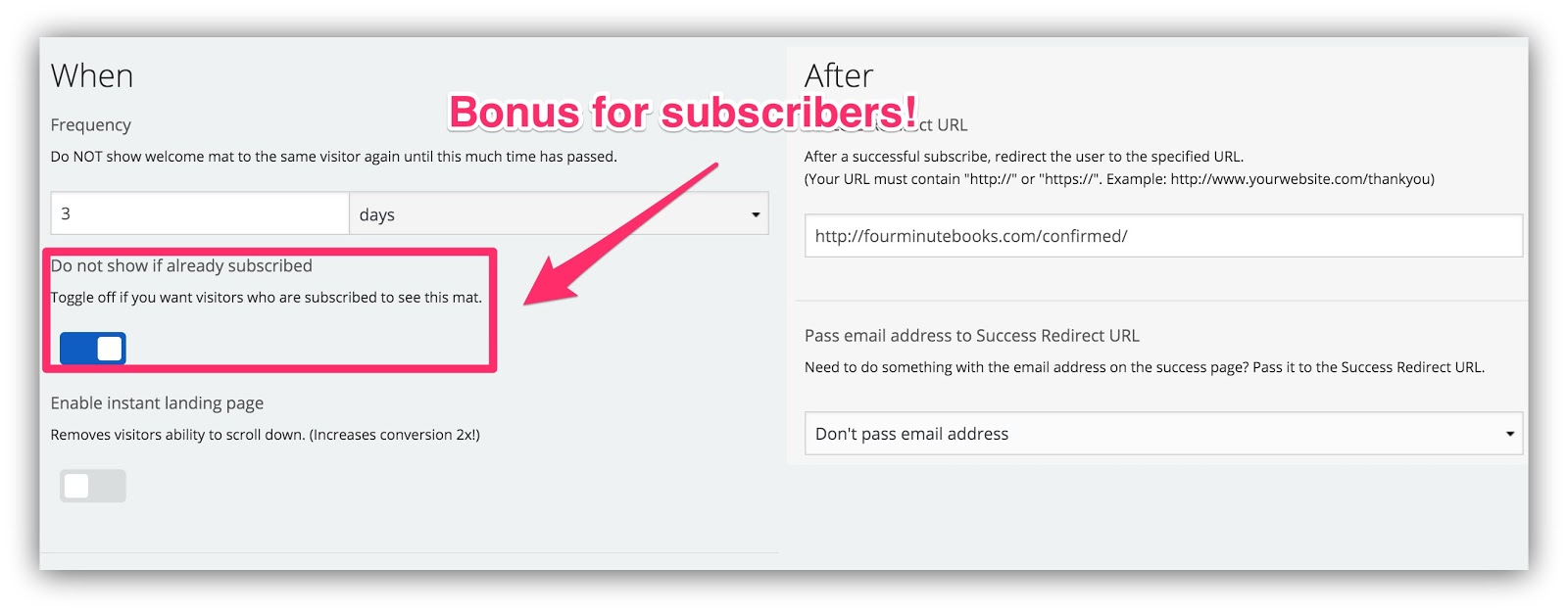
Pro tip #2: Enable instant landing page to 2x-10x your conversions.
Once you have Welcome Mat set up, don’t overlook List Builder.
List Builder
Welcome Mat catches people’s attention when they first go to your website, and List Builder gives them one last chance when they’re about to say bye-bye.
To make it more fun than the regular “sign up for our list” popups, I copied what Wait But Why did, and gave the popup a human touch.
Here’s Wait But Why’s List Builder popup:

This is mine:

Noah said in Email1k that you should get at least 2% of your traffic to sign up. With a bit of creativity, you can get there, and even beyond.

Once you get List Builder set up, don’t forget Scroll Box.
Scroll Box
Two is company, three’s a crowd, so Scroll Box can’t miss this party! Since it’s triggered when people scroll down the page, it’s likely to pop up for return visitors who might’ve skipped your List Builder popup.
Therefore, I like to relate the two, in line with the “human popup” theme.
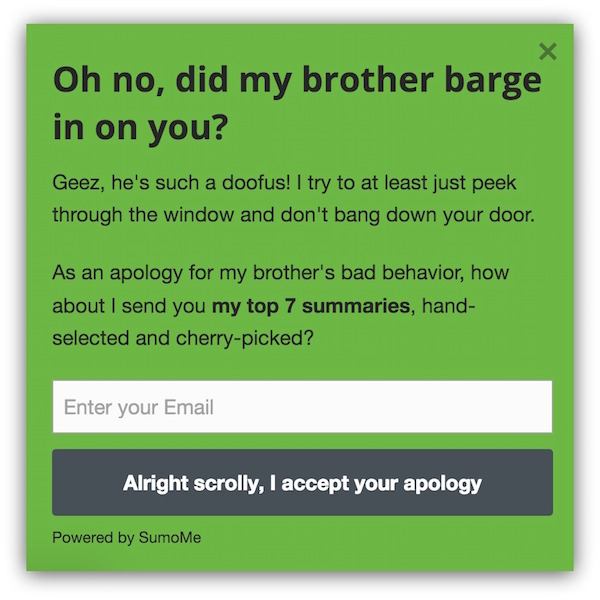
Again, being funny does the trick here. 1-2% is a decent conversion rate for scrolly.

That’s really all there is to collecting emails.
With these three tools combined, I convert over 8% of all website visitors into email subscribers (if you’re not familiar with average conversion rates, that’s really good).
Forget sidebar banners, feature boxes, or other difficult to implement tactics, which only make the user experience worse. Rather spend a little more time on coming up with good copy for your three musketeers and you’re good to go!
Part #4: Promotion
When I spend 1-1.5 hours writing a post every single day, the last thing I want to do is spend another 90 minutes promoting it.
But promotion is important, so don’t skip this step. Don’t worry, it won’t be too much work.
Instead of coming up with massive email outreach campaigns for each blog post (which won’t get you results anyway, because, let’s face it, your posts won’t be rockstars), spend a very focused 10-15 minutes in a few channels, right after publishing each post, which starts their sometimes even viral journey through the web.
Here’s the exact promo checklist I run through every single morning:
- Submit to StumbleUpon
- Submit to Hacker News
- Post to relevant Slack groups
- Send post to 1 person via email
- Tweet at input creator
- Buffer tweets
- Check in on coach.me (or another community you’re a part of)
10-15 minutes a day adds up to over 5 hours a month, which makes your promotional efforts manageable on a daily basis, but the effects compound fast.
Here’s how to get massive results in less time with my promotion strategy:
StumbleUpon (The Secret Sauce)
Had I not stumbled upon StumbleUpon (pun intended), you’d not be reading this post right now.
StumbleUpon is a social network that shows you random pages from the web based on topics you’re interested in. You can like, dislike, or simply “stumble” and get a new page. Content creators can submit a page or post to StumbleUpon, rounding out your content promotion strategy.
As soon as you publish your post, add it to StumbleUpon.
It is my major source of traffic.
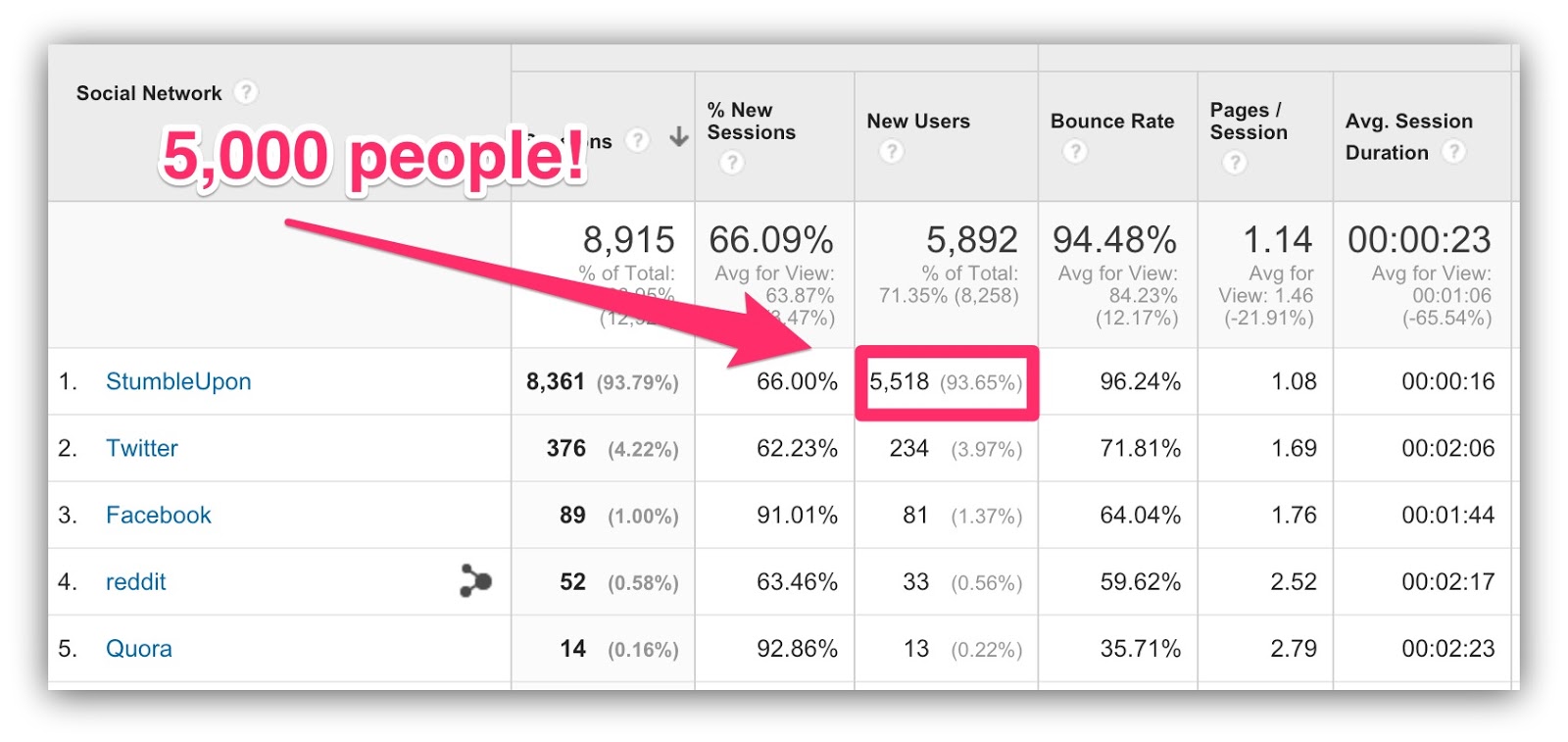
The traffic is a bit ADD, but that’s just in the nature of the network.
However, those that don’t just instantly “stumble” and jump to the next piece of content, usually read all the way to the end (Stumblers enjoy shorter posts) and often sign up to my email list.
People don’t talk about it often because usually they don’t produce enough content for this platform to pay off.
From my experience, about 1 in 10 posts goes viral, sending thousands of people to my site.
If you only publish once a week, it can take forever. But when you publish daily, StumbleUpon really starts to pay off.
When you add your page, be sure to add as many relevant tags as you can think of since they’re the only indicator by which people find your posts initially.

Pro tip: When you notice a flatline, ask a few friends to give all of your latest posts a thumbs up – a single like can fuel your posts for days.
Hacker News
Hacker News is a huge news site around tech, business, and marketing. You can simply submit a link, set a title, and if people like it, they upvote it.
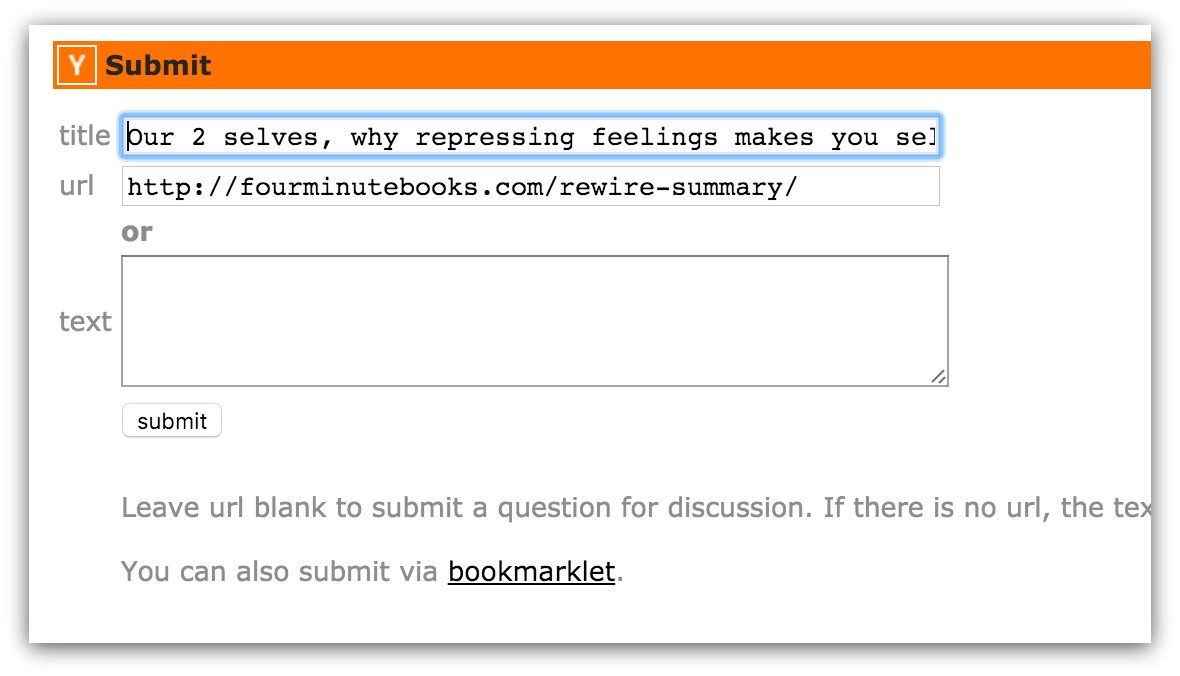
I submit all my summaries about relevant topics there, the ones about startups, marketing and business do best.
Similar to Hacker News, there are plenty of other niche specific aggregators, where you can submit your content to. For example Rockstar Finance for all things money and Taste Spotting for delicious recipes.
Pick one or two that fit your industry, and make them a daily stop for your content.
Slack Groups
Besides being the go-to instant messenger solution for most startups these days, many groups form on Slack around certain topics.
For example, Product Hunt has its own Slack channel for community members all round the world, called Product Hunt Global.
It has over 2,000 members, which are interested in tech products, apps, web content and gadgets.
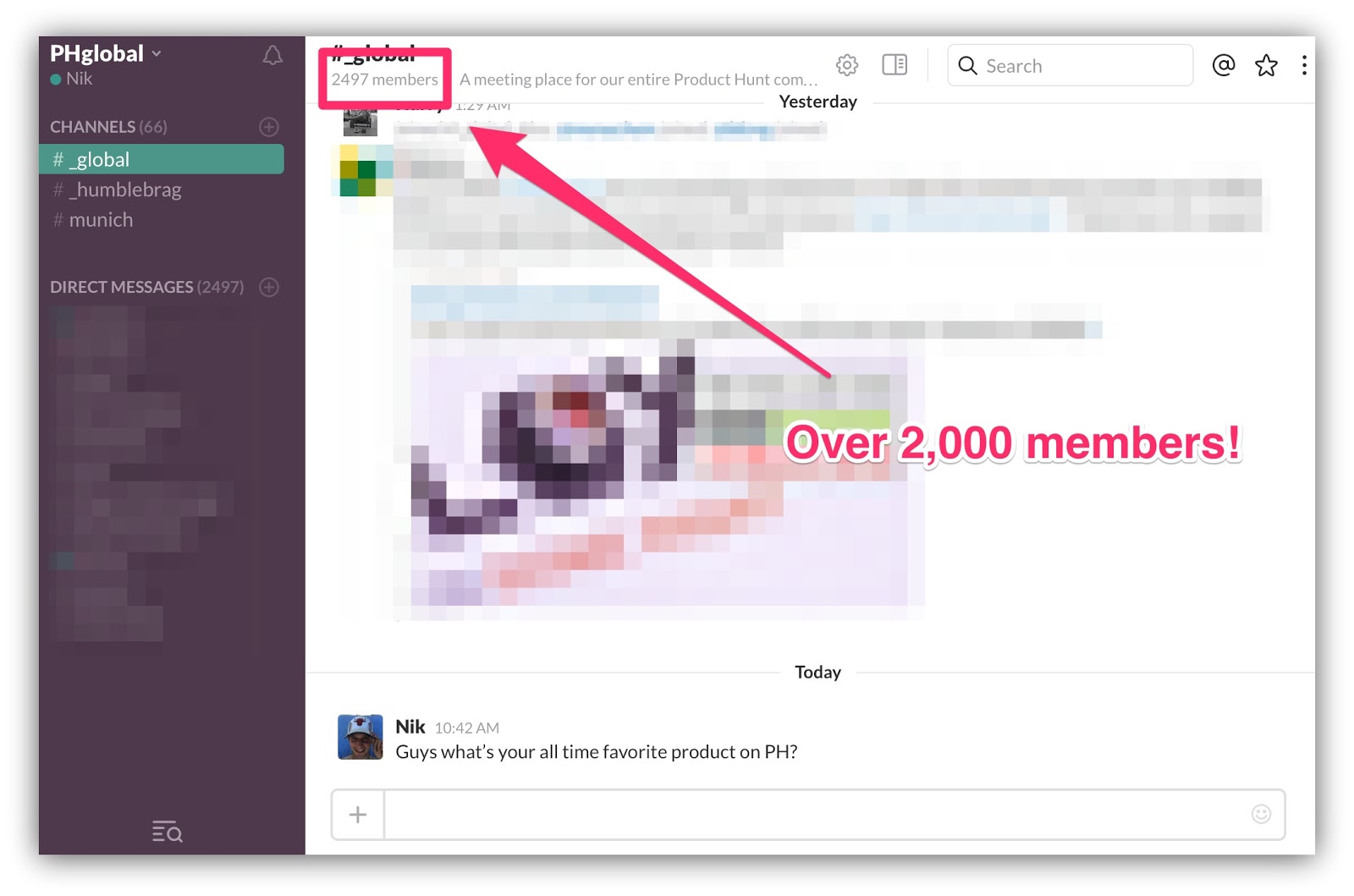
I can see your eyes lighting up right now, but as with anything that lends itself to spamming, your gut feeling is right when it tells you: don’t.
Only drop your content in channels where self-promotion and random sharing is encouraged, (they’re often called #random or #promo).
For example, I’ll often share my summary of the day in our coach.me Slack in the #random channel:
 Alternatively, send your content to 1-2 members via direct message, who you either have talked with before or know are interested in the topic you just wrote about.
Alternatively, send your content to 1-2 members via direct message, who you either have talked with before or know are interested in the topic you just wrote about.
But where the heck are you supposed to find all those Slack groups? I got you.
- Chats Directory is a collection of several dozen business focused Slack channels for various industries
- ChitChats is a curated directory of over 600 Slack groups around all kinds of topics.
- Slacklist has another 64 channels and growing.
Plus, Angela Cois published an extensive list of 118 channels on Medium, so take your pick
Sending ONE Person An Email
One email to one person per day comes out to 30 new people each month who learn about your website – don’t underestimate that.
Whenever I’m done writing I ask myself: “Who of my friends would find this interesting? Which person I know could benefit from that post the most?”
Here’s the dead simple email template I use to send it to them.
Hey [NAME],
had to think of you as I wrote my blog post about [TOPIC] this morning. I remembered it’s something you’re interested in, so I thought I’d share: [URL]
Would love your thoughts on it, as you know your way around the topic well.
Hope all is well,
Nik
It’s a great way to reconnect with people you haven’t talked to in a while, plus you’ll get constant feedback about your content.
Pro tip: Take it one step further and add a slight nudge to check out your new site to ALL of your emails with the signature technique my friend Cathryn showed you on the blog previously.
Tweet At The Content Creator Of The Post You’ve Read
What do good Sumos do when they learn from somebody?
They tell them!
Since I’m doing book summaries, I always tweet at the author of the book that I wrote about their work.
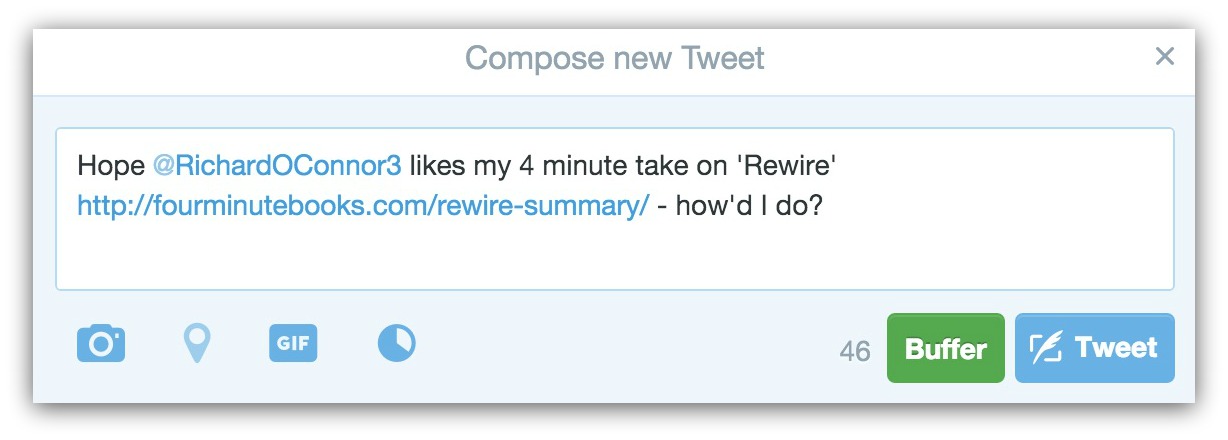
Usually, the least I get is a favorite…

…but sometimes, this happens:
I liked this "4-Minute Summary" of The Happiness of Pursuit — https://t.co/TV28uQmyCD
— Chris Guillebeau (@chrisguillebeau) February 10, 2016
When creators and influencers share your content, several good things happen:
- Your content gets exposed to more people.
- Google picks up these social signals, which helps you rank higher.
- You can use their tweets as social proof to build authority and credibility.
Depending on where you get your content from, you can even go further than this. For example, if you’re using a Youtube video as an input, the least you can do is write a comment…

…but you could also make a short video yourself and share what you’ve learned, make it available publicly and also post it as a comment.
On Quora, you can simply republish your slightly modified content as an answer to the question you used as a resource and easily get a few hundred extra eyeballs on it.
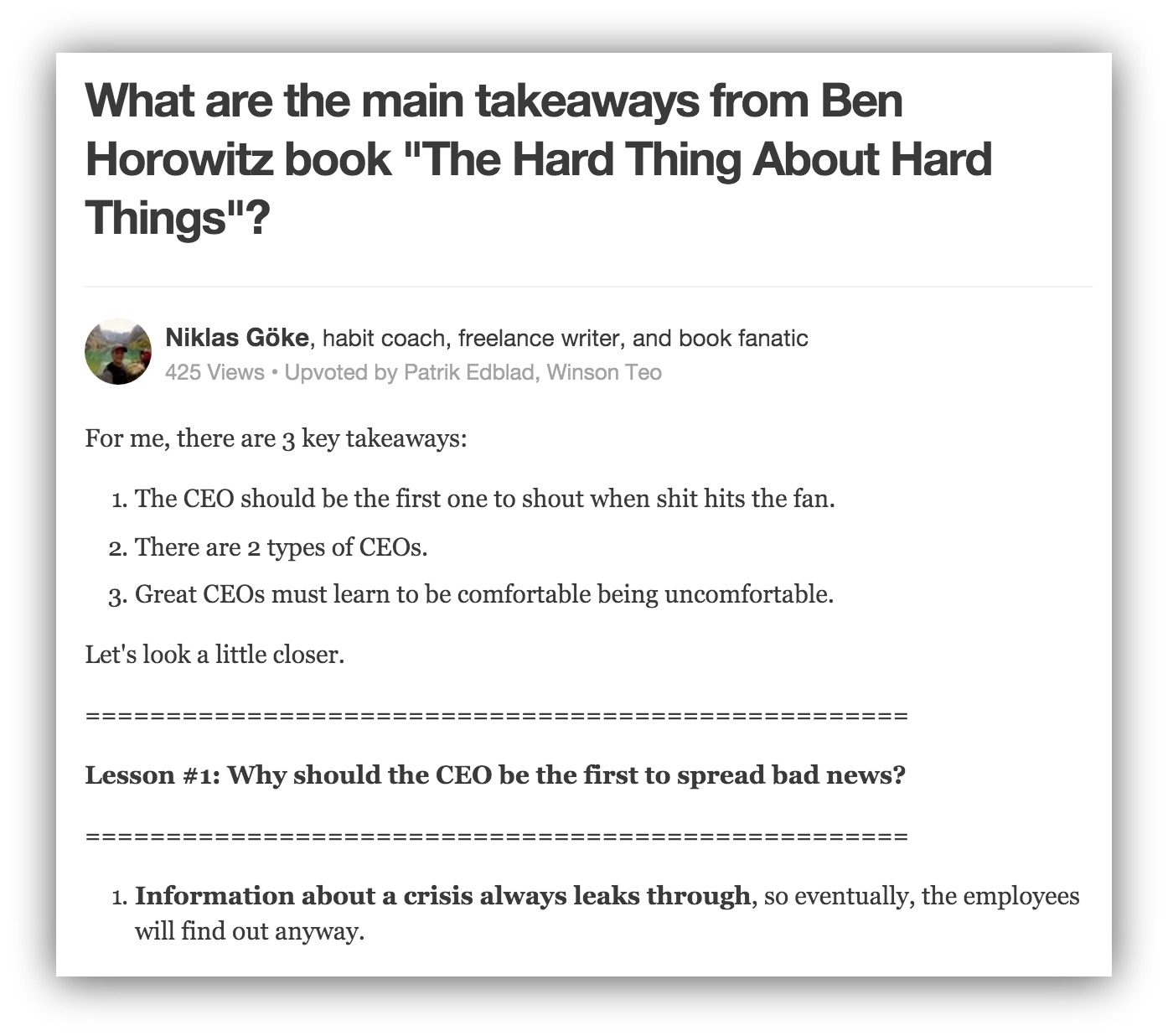
Medium even has a response feature, you can directly respond to the author of any article, right below each post.
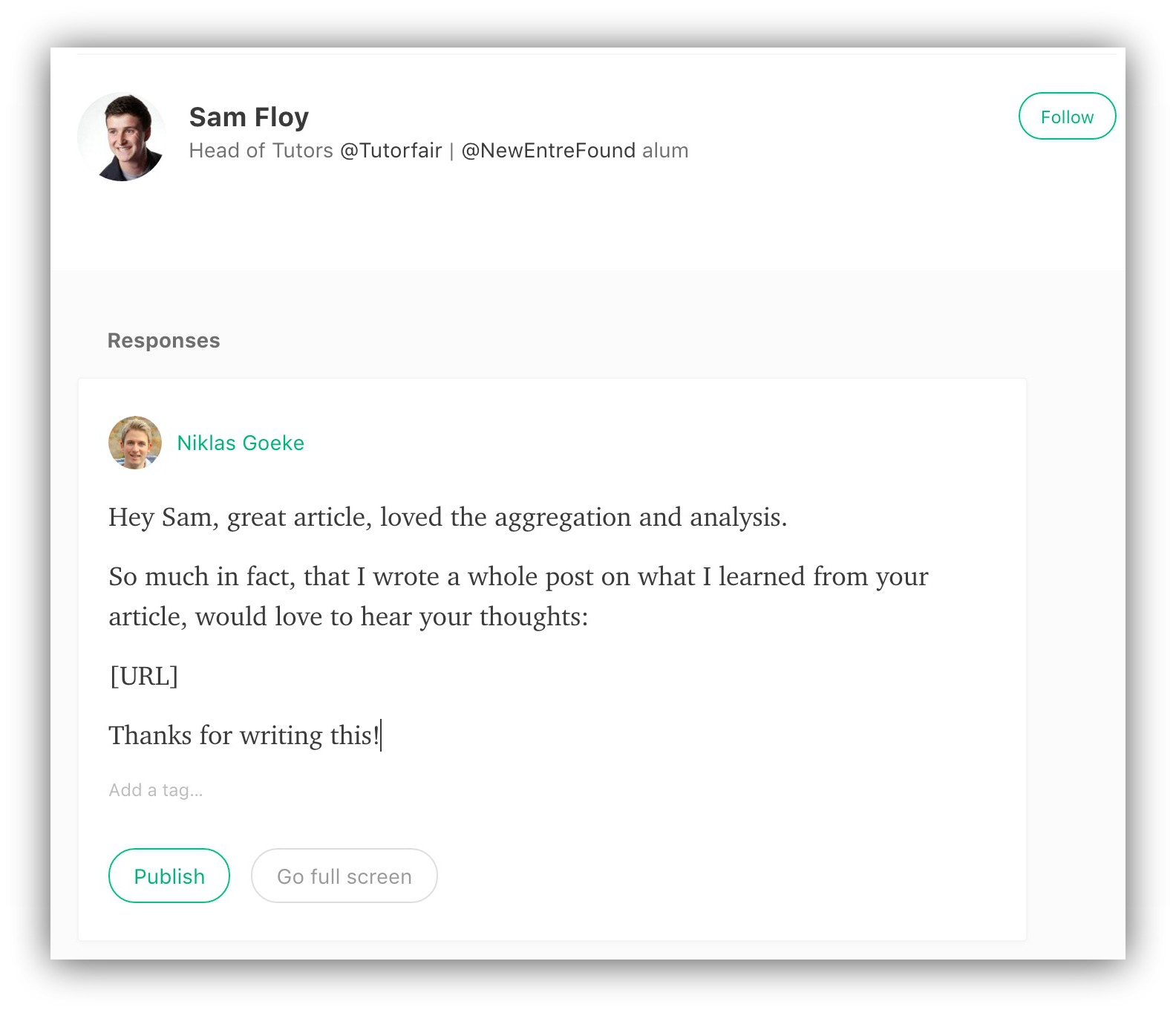
Whichever source you’re drawing your daily input from, make sure you tell its creator what you’ve done with it.
Buffer Tweets & Shares
Another 2-minute no brainer.
Schedule several tweets and other social media shares throughout the week, be sure to include relevant hashtags and tweak the message a bit each time.
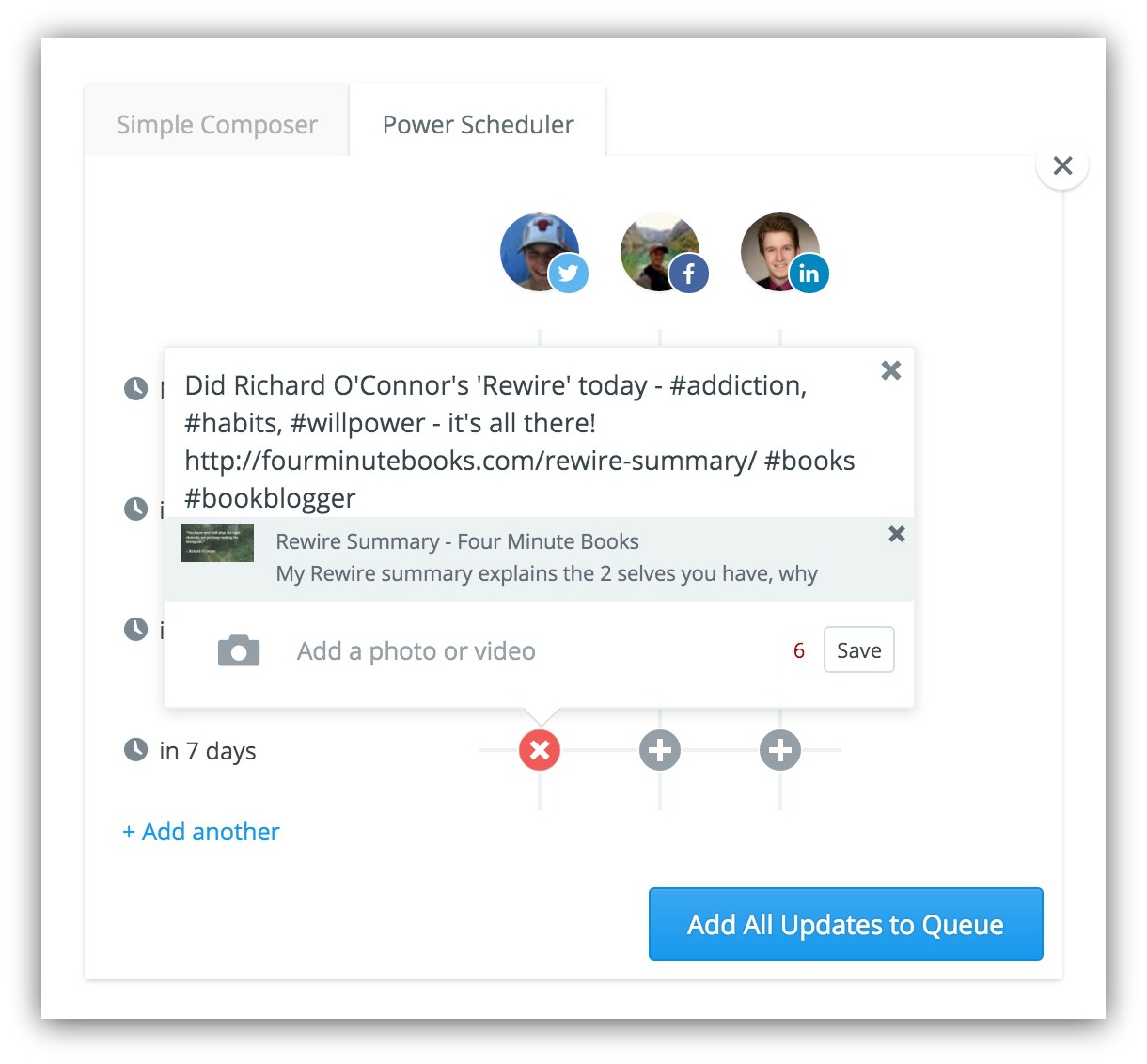
Pro tip: If you’re on the free Buffer plan, don’t schedule a Tweet to go out instantly. Tweet yourself instead to make sure you don’t hit your 10-post limit with the scheduled tweets.
Check In On Communities You’re Part Of
I track all of my habits on coach.me, including my writing.
Over time, I’ve accumulated over 400 followers on the platform, who see my check-ins, so naturally, when I publish something, I include it in a note.
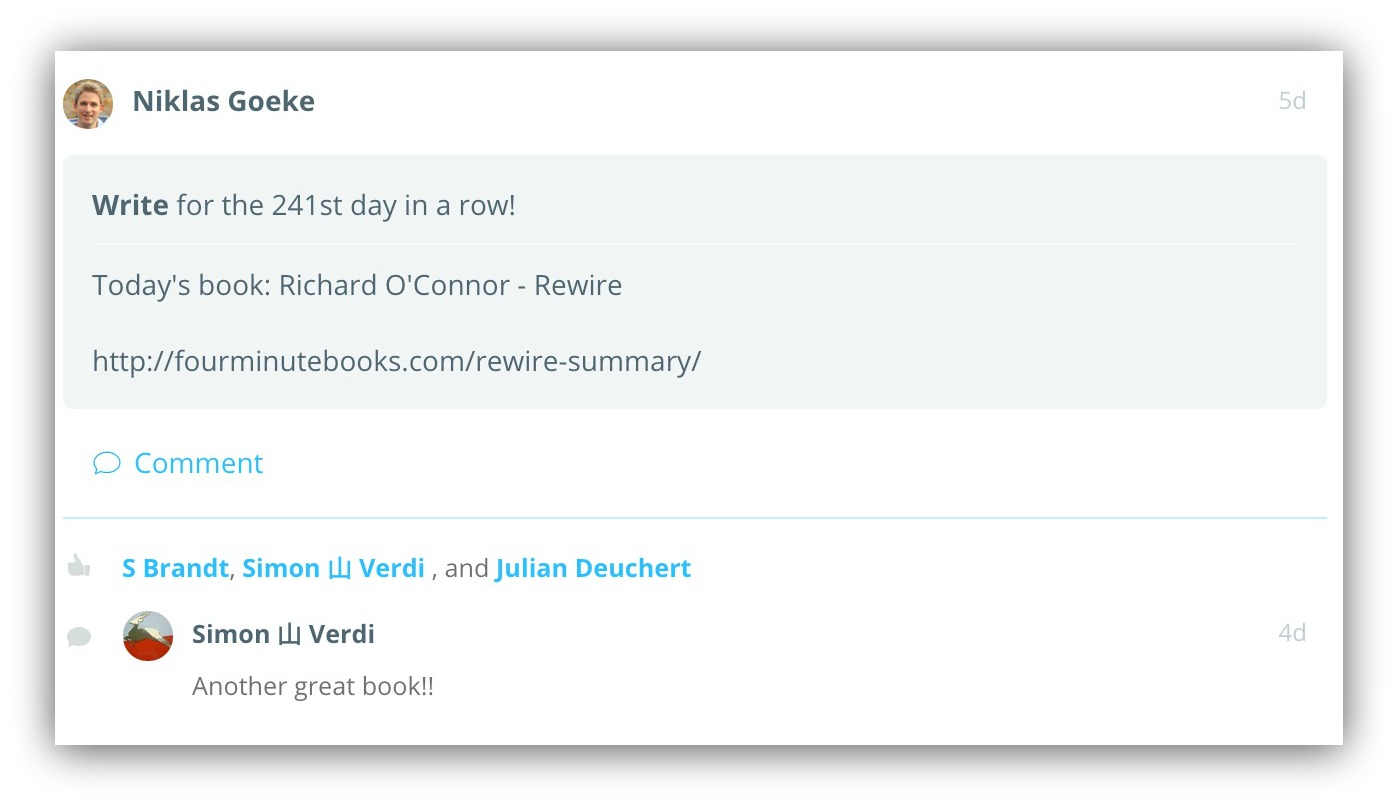
Think about which communities you’re already a part of.
It might be a forum, a Facebook group or an app you’re using. Do a daily accountability check-in and let people know what you’re up to.
Done!
Your promotion checklist is complete, now all you have to do is save it. I keep mine in Evernote.
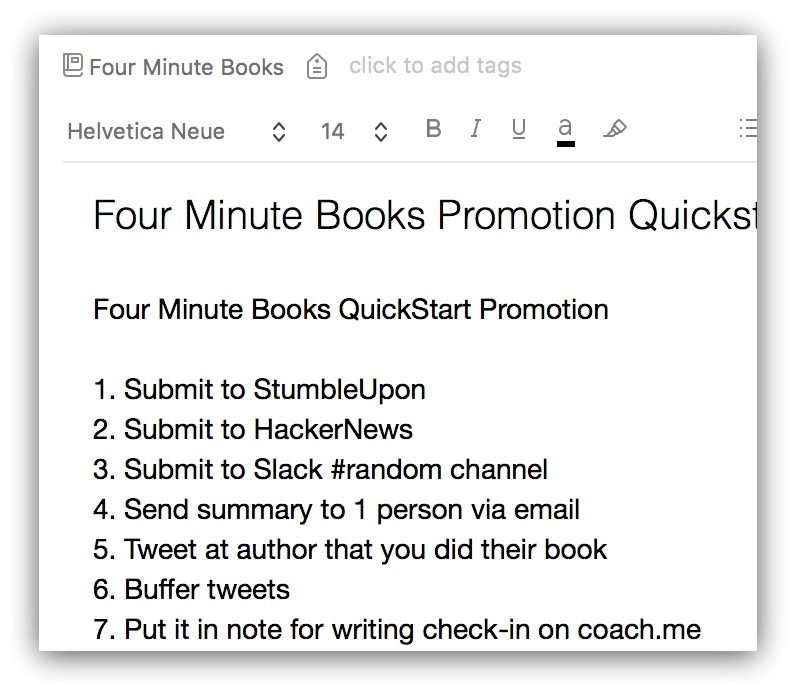
Got your promo checklist saved and ready to go? Alright, the content firework is about to begin!
Step 3: Press Publish. Every. Single. Day.
Woohoo, prep work done.
Now the fun starts
Time to execute like a madman!
Read, learn, write repeat. The reason this system works so well is because you don’t have to think. In order to keep it that way, I suggest you create a rigid structure for your daily writing and stick to it like a monk to his monastery.
Here are 2 rules to help you do just that.
Write At The Same Time Every Day
I don’t care whether you write at midnight, in the morning, or at 2:43 PM, as long as it’s the same time every day.
Your circadian rhythm suggests your alertness is highest at around 9 AM in the morning, which makes it a good time for synthetic work (i.e. writing), but if midnight works for you, more power to you.
Whatever your writing time ends up being, put it on your calendar and protect it like you’re a bulldog.

Use The Pomodoro Technique To Stick To Your Limits
It’ll be tempting to spend more time on your posts to make them better.
Don’t.
Shipping something that’s 80% done feels just as good as shipping something that’s 100% done.
To make sure I don’t exceed my research and writing phases I use the Pomodoro technique. I aim for 1 input Pomodoro and 1 output Pomodoro each day.
At your designated writing time, set a timer for 25 minutes,hit go, and start looking at your input resource.

As soon as you’re done reading the article or watching the video, start writing.
When the timer rings, set it again, this time to 5 minutes. Take a break. Get up. Move around. Open the window. Go to the bathroom. Have some tea.
You get it. Whatever you do, don’t work. After the 5 minutes are up, set it to 25 minutes again and write as if your life depends on it.
When the timer rings for the second time, press publish.
Yes, some days you might have to throw in a third block. Yes, some days you’ll get lost down Google’s rabbit hole. But after doing this for a while, you’ll see you can indeed publish a post with 50 minutes of work.
After you press publish, you can proudly sip your morning coffee, run through your promotion plan and watch your traffic and email list soar to new heights.
Your Turn To Turbocharge Your Website’s Growth
I officially launched Four Minute Books on January 11th, 2016, with a Medium blog post.
Exactly 60 days later, the website had attracted over 28,000 unique visitors, 837 email subscribers and made $736.00.
I’ve just given you an exact blueprint to do the same thing and I want you to succeed as much as I want to succeed myself.
Here are the steps again.
Step 1: Figure out your “Why”, crunch your numbers and validate your idea.
Step 2: Build a content log and streamline SEO, email collection and your promotion process.
Step 3: Show up tomorrow and start pressing publish every day until you hit your goal.
This was a long guide, but instead of lying down and taking a nap, here’s what you should do right now:
- Bookmark this article. Seriously. Bookmark it. Doooo it.
- Make a cup of strong coffee.
- Get to work!
It’s a big commitment, but everything worth having is.
To help you kick even more ass, I’ve compiled a bonus package with all templates from this post, tech walkthroughs and a few hidden goodies. You can get that here.
Let me know what you thought of this guide and have fun making your own luck!












Add A Comment
VIEW THE COMMENTS